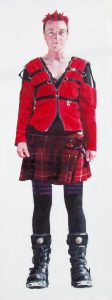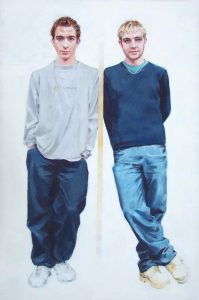Contents
Chapter 2 – Recovery – ( Space(s) – Arrows – Pipes – Roads and Houses )
Chapter 3 – Chorley College – ( Photography and Action Man – Girl – Cutouts )
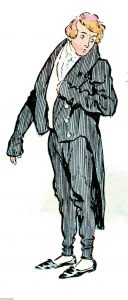 First, the title. It is, quite simply, a sentence my mother used to utter. She was a tailoress and spent her life making men’s suits. She would knock off a pair of trousers in the morning then cut out and baste up a jacket in the afternoon. She was proud of her skills and very critical of the products of other people’s. ‘It fits where it touches!’ was her greatest insult. It often came shortly after ‘They are nobody,’ which alluded to the suit owner’s lack of pedigree. She claimed to be of the landed gentry, because her grandparents had been, or so she said. She certainly wasn’t when she had me and my brother. Not only was she a poorly paid seamstress but her husband, my father, worked in a cotton bleaching mill where he had reached the heady level of foreman before dying suddenly of a heart attack when I was fifteen.
First, the title. It is, quite simply, a sentence my mother used to utter. She was a tailoress and spent her life making men’s suits. She would knock off a pair of trousers in the morning then cut out and baste up a jacket in the afternoon. She was proud of her skills and very critical of the products of other people’s. ‘It fits where it touches!’ was her greatest insult. It often came shortly after ‘They are nobody,’ which alluded to the suit owner’s lack of pedigree. She claimed to be of the landed gentry, because her grandparents had been, or so she said. She certainly wasn’t when she had me and my brother. Not only was she a poorly paid seamstress but her husband, my father, worked in a cotton bleaching mill where he had reached the heady level of foreman before dying suddenly of a heart attack when I was fifteen.
Actually, come to think of it, what my mother meant by ‘It fits where it touches!’ – i.e. it doesn’t fit at all – is not what I mean in the title. For me this little sentence just suggests the randomness that I see when I look back at my artistic life (calling it a career would be more than misleading). From the relative objectivity that time provides it is fascinating to note the degree to which circumstances decided what I produced. This is as it should be, of course. If art’s about anything it’s about reacting to whatever’s around you.
Of course the artist’s environment and external stimulus are only part of the equation, the other being the artist himself – or herself. What follows is a description of my responses, what they were responses to and how they developed. I’ve tried to make it interesting. Of course, whether it is depends to some extent on the artwork itself. By this, I don’t mean whether it’s any good or not. Trying to decide where any work fits into the great artistic scheme of things in terms of quality is, I increasingly find, an impossible and often distracting activity. These days I just try and react to whatever I see as best I can and leave it at that. Deciding whether your own past work is any good is definitely impossible. This is not to say you shouldn’t aim for excellence when you’re making the stuff, merely that, once it’s in the past, it just is what it is and that’s all.
There is another way in which the title is appropriate. My memory fits where it touches too. My recollection of things on the distant past is frighteningly incomplete. What’s more it seems almost randomly so. Why should I remember a piece of sculpture I made in my first year in the Sculpture Department of Manchester Art College well enough to reconstruct it on paper yet have forgotten others that I produced much later? Only the discovery of some contemporary photographs reminded me of some of the latter, others have almost certainly gone for good.
And talking of the photographic record: that too leaves a lot to be desired. Some of the gaps are down to simple bad luck but other problems are self inflicted. I may have copped out of deciding how good my old art work is but I can’t escape the fact that I was, and still am, a useless photographer
Chapter 1 – Art College
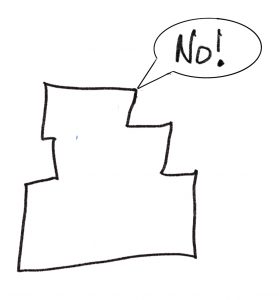
A Negative Shape?
“You’re not looking at the negative shapes,” said the lecturer accusingly. He was a small bearded man and looking back over the fifty years which separate now from then, not all that much older than I was. Having said that he was a lecturer, and lecturers by definition, knew everything. They knew what a negative shape was, for one thing.
I didn’t. A shape was just a shape as far as I could see, in this case the shape of the pile of easels we’d been set to draw. A shape could be too fat, too big or just wrong – but negative? How could it be negative? Even in Maths, where negatives lurked around every confusing corner, the term had never been applied to shapes, not in my five years at grammar school at any rate. Shapes in maths had names and classifications, and they usually had letters attached to their corners for use in theorems. But negative?
Worse still, it seemed to be just me who was ignorant. The beard had been talking to me, but had said it loud enough for everyone else to hear. No one had asked what a negative shape was. They obviously knew.
Well, I wasn’t showing my ignorance, not in my second day at Manchester Regional College of Art. Not likely. I kept quiet. Needless to say, I couldn’t do anything else to the drawing. I might make the negative shapes even worse. I just sat and fiddled with it a bit.
And it had all started so well.
On the first day we’d been put in temporary groups and this nice lady lecturer (the lady bit making her unique in the establishment as far as I can remember) had us drawing potted plants. What’s more she had held up mine and said, “Now that’s what I’m looking for!”
It actually felt quite normal to be singled out for special praise. It had been happening since I was nine, when my primary school teacher had announced that he’d found an artist. Being another educational god, not to mention something of an artist himself, I took to his praise like a duck takes to small fish. I worked very hard from then on to get more of it. I don’t know whether it was natural talent or just the hours I put in but I actually got quite good at drawing. What’s more, the results began to garner praise from more than just my teachers. Friends and family alike were impressed by my developing skills. They made me special. It quickly became something I couldn’t give up.
Somehow I passed my eleven plus (the somehow being a private tutor paid for by my far from wealthy, working class parents) and went to grammar school, a very good grammar school as it happened. Unfortunately, in the mid fifties, this meant treating their pupils as information receptacles, the filling of which was achieved by writing stuff on a blackboard and having said pupils copy it down. I didn’t take well to this. Usually my mind wandered off to somewhere a lot more exotic, usually to the accompaniment of some above average doodles.
Of course it was different in the Art department. In there I was a star. When the school got a new young head of Art in my fourth year I became the star. I also had my eyes opened to a thing or two.
It seems difficult to believe it now but, with the sixties still in the future, Impressionism was seen as a bit rubbish in the cotton towns of Lancashire. Not as rubbish as Picasso, admittedly (he was quite obviously a lunatic conman, even the newspapers said so) but nowhere near as good as the likes of Constable and those other honest British artists who painted nice things that looked real. But given a combination of adolescent rebelliousness, the new art teacher (who’s name, appropriately, was Young) and something in the British air that would eventually culminate in the Swinging Sixties, I was soon taking the view that Constable was a little bit last season.
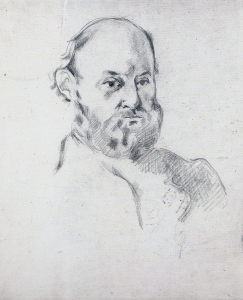 It would be nice to announce that I now caught a glimpse of the contemporary art world, said ‘Yes, that’s for me!’ and dived in with gusto. Alas no. I merely managed to crawl forward a few decades through the nineteenth century. Presumably with the help of Mr. Young I discovered Cézanne.
It would be nice to announce that I now caught a glimpse of the contemporary art world, said ‘Yes, that’s for me!’ and dived in with gusto. Alas no. I merely managed to crawl forward a few decades through the nineteenth century. Presumably with the help of Mr. Young I discovered Cézanne.
It wasn’t the greatest leap forward in the history of art but then I was only fifteen; I wasn’t ready for Abstract Expressionism, even if I’d seen any examples of it.
But, looking back, Cézanne was a significant discovery. What I liked about him was the way he constructed his images from visible strokes. I started constructing my drawings out of short straight marks. In addition to accuracy they now had style. I had discovered ‘mark making’ though the term wouldn’t be in use in educational circles for a several decades. Unfortunately the discovery didn’t survive my first few days at art college. And ironically, one of the nails in its coffin was provided by a man who was, I now assume, trying to promote it.
Lecturers in those first few days seemed to change daily though that’s probably a trick of memory rather than an accurate recollection. This one was bald and wore a suit (which wasn’t that odd in an art college in nineteen sixty – give it three or four years and it would be start to become odd). Bald, suited man took us into a nearby park, pointed down at the uncut grass and said he wanted us to draw it. ‘But I don’t want to see any blades of grass,’ he announced pointedly. Of course I know now what he meant and perhaps I should have known then given my Cézanne inspired drawing style. He meant that we should make marks to represent the grass, its flowing swirls and spiky clumps. The trouble was he didn’t say that – he preferred enigmatic to explanatory, leaving me and most of my fellows more than a little confused. (The exception was this mad girl who nobody really talked to. She was off on her own behaving madly as usual, rotating on one leg in a mad little dance. Of course she wasn’t being mad at all. She was creating patterns in the grass which she would then translate into a bold and vibrant drawing in charcoal. Of course we didn’t look at what she was doing. She was mad after all).
He didn’t even explain when we questioned him later, after we’d all scribbled a bit and given up. He just said he ‘wanted to destroy our preconceptions’. He didn’t even show us the mad girl’s drawing. The truth was, I suspect, that he didn’t really want us to understand. He’s either dead now or very, very old. Serves him right.
It is, of course, unfair to single out one bald man in a suit as responsible for my confusion. The whole place was confusing. Everywhere you looked there were paintings, drawings and prints that just looked like inept, meaningless scribbles to me. Yet they were praised. Cézanne was last season as well, it seemed. This was the latest fashion and it looked bloody awful to me.
I didn’t fret about all this. The young are used to not understanding things, it goes with the territory. I somehow believed that if I hung around long enough there would come a point when a light would go on and I’d suddenly understand. And I wasn’t on my own. Other people were confused too. One or two of them even admitted it.
But for me the lack of understanding took away my ability to work. How could I draw, paint or make anything when I hadn’t the slightest idea whether my output was any good or not? Even praise proved destructive.
‘Excellent,’ one of the lecturer gods said about a life drawing I had almost completed in his weekly lesson. ‘Pity you’re not using a softer pencil.’ He didn’t say why it was excellent, why it was it any better than the drawings I’d done in previous weeks, or why I should use a softer pencil. All of which left me with nowhere to go. I certainly couldn’t touch my excellent drawing. I’d probably ruin it.
I was apparently capable of excellence but didn’t know what excellence was, a belief that was reinforced when the same lecturer praised the work of other people which looked rubbish to me (like the mad girl’s). I’m not saying it was rubbish; it was probably just too sophisticated for my severely uneducated palate. Whatever the truth, the result was that an artistic stasis descended on me.
It might have helped if the lecturers had explained a bit more. But they didn’t. In retrospect this isn’t all that surprising. These mostly young lecturers claimed neither expertise nor interest in education. They were artists, and artists don’t explain. This is not, as many then believe, because they’re trying to con everybody. It’s more that explanation requires analysis, of a kind which runs counter to the whole process of making art. Analysis is dangerous. Art is done by ‘feel’ and feel is a delicate creature. Letting logic near it can kill it.
Of course they couldn’t explain this either.
As for the learning, I think that was supposed to take place by osmosis.
Given my by then total lack of confidence and consequent inability to do anything it is something of a miracle that I survived the next two years. At the time, but not for much longer, a two year, mixed syllabus of drawing, painting, sculpture and craft ended in the Intermediate examination. I remember virtually nothing about this examination, apart from having, on the advice of my craft lecturer, to abandon the pots I’d spent most of the allotted two weeks making and attempt the other of the two options. I designed, threw, turned, fired and glazed a tea caddy in three days (proving, if nothing, else that I did, even then, have the capacity to work, given a clear target and enough pressure). Despite this, no one was more surprised than I when I actually passed. God knows how I did it. Perhaps I produced another brilliant drawing.
It was time to specialise.
What to specialise in was a no-brainer, though an older interpretation of this expression might be more appropriate than its actual modern one. Despite the fact that I was in a state of artistic calcification borne of confusion and lack of understanding with regard to painting in particular, I applied to join the Painting Department.
It is perhaps worth pointing out that Manchester Art College was an exciting place at this time, full of exciting and charismatic people. And the most charismatic of all were the painters. I wanted to be one of them. Surely the penny would drop eventually if I just stayed around for long enough. And who knows, the Painting Department lecturers might make it happen – they were the real experts after all. They weren’t, it turned out, prepared to make the effort. They took one look at my pathetic excuse for a folder and pointed their painterly thumbs at the floor. ‘No thank you. We were all at college with David Hockney (most of them had been, at Bradford); we can afford to be choosy; we only take people who’ve actually done something over the last two years. Thanks for coming. Don’t forget your folder, you might want to put something in it sometime.’
Fortunately, the Sculpture Department weren’t so choosy.
There was a reason why the Sculpture Department wasn’t choosy – it was in almost as bad a state as my folder. It was situated in the cellars and walking into it was, at first glance, like walking back into he 19th century. My first memory of it was of several almost finished, life size, clay life figures being worked on by students who looked a bit old fashioned themselves – they looked more artisan than artist.
There didn’t otherwise seem to be a lot going on. The head of department, we soon learned, was a raving alcoholic whom nobody had seen for months and almost certainly wasn’t coming back. In the meantime the department was being run by two relatively older men called Norman Aspinall and Bill Bailey. Norman and Bill were facing something of a crisis.
Manchester Regional College of Art was about to be transformed into Manchester College of Art and Design. And this was to be no mere cosmetic change. It was part of a transformation of the whole of higher education in Art. The National Diploma in Design (NDD) which I was about to embark on, was being replaced by the Diploma in Art and Design (DipAD). There were all sorts of dramatic differences between the two courses, many of which were to affect me personally, but the most immediate was that NDD was a two year mixed course followed by two years specialisation whereas DipAD was one year mixed followed by threeyears specialisation. This meant that the first of the DipAD students were starting their sculpture course on the same day that we were. Poor Aspinall and Bailey found them selves with three groups, one in it’s final NDD year, facing an exam in six months time, one embarking on an exciting, spanking new course (which, incidentally, most of the smaller Art Colleges in the country weren’t allowed to do), and us. Guess which group got sent to the zoo for a week to draw the animals. And guess which group were stuck in a converted corridor when they got back and left to their own devises for the first term.
I actually enjoyed those few weeks. We bonded, we forgotten few. What’s more I was able to get on with some work without any danger of a lecturer coming in and saying something confusing about it. I was actually producing an abstract piece in plaster when one did. It had started off as an image of two grappling wrestlers (a starting point provided by Mr. Aspinall I think) and ended up, after a good deal of simplification through drawing, as a kind of Barbara Hepworth-like egg shape.
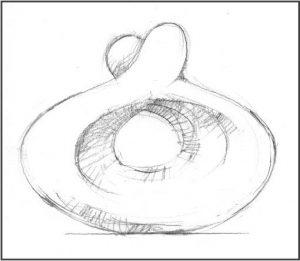
The next three years were some of the most exciting and frustrating in my life. Exciting because there was an artistic revolution going on around me and frustrating because I didn’t have the confidence to join in. I’ve long been fascinated by the human ability to hold two completely contradictory views at the same time, but that’s exactly what I managed to do during that period. I was able to believe myself to be an artist working at the cutting edge of the modern art world whilst being so confused and lacking in confidence that I did virtually nothing in the form of artwork at all. I spent most days in the pub where I got very good indeed at darts and table football.
To be fair, I did actually make some sculpture and some of it did, I’m sure, have merit. But none of it ever went anywhere. And my lecturers couldn’t do anything about it. I don’t know to what extent there were aware of this – Henslar once told me that I only talked sense when I was drunk. This meant, in fact that I must have made sense quite often, but never unfortunately in circumstances, or for long enough, to be any use. And what I did make was in the exciting new materials of welded metal and plastics that the DipAD students were using so that, when I came to the old fashioned, Victorian, academic NDD examination (for which you could work in any medium you liked as long as it was white plaster, and no bigger than two foot six) I struggled. And failed. They let me do another year during which I did more stuff in a variety of media, and failed again.
I went back to Chorley, where I’d come from; an ex art student with no qualifications to speak of.
Below are some recently discovered images of ‘work’ I did during those uncomfortable art college years. What is interesting is that although I could remember ‘The Wrestlers’ sculpture (above) well enough to reconstruct it, I had actually forgotten these pieces until I rediscovered the images.
Back To Contents.
Chapter 2 – Recovery
So there I was, out in he world with a big F stamped on my forehead. Two F’s really, having failed the NDD exam twice.
I carried on trying to make art for a little while. Pure momentum I suppose. None of it survives in any form, even memory. I do have a vague recollection of messing about with toy soldiers and epoxy resin but the most solid recollection is of that familiar and uncomfortable feeling of not really knowing what I was doing.
I even gave up on art for a while. I sought out other intellectual stimulus in the local library, going through the non fiction shelves, almost at random.
I learned quite a lot, about a lot of things, from Ethology to Egyptology, Ancient History to Astronomy. I particularly liked books about Science. In fact I’m tempted to suggest that I discovered Popular Science before it became truly popular. (Why, oh why, I wondered, had I not paid more attention at school – and then I discovered my old History textbook from school – History being another favourite from the library shelves – and discovered that it was just as boring and impossible to read as I’d found it at fifteen.) Interestingly, one of the subjects I didn’t read about was Art.
It wasn’t all intellectual stimulation though; I did get myself a job as a bus conductor, in order to feed, clothe and house the wife and child (soon to be two) that I had managed to acquire. This, the bus conducting, turned out to be a significant move in terms of my artistic development.
Most of the buses by then were, in the vernacular of the trade, ’front loaders’ meaning that the doors were no longer at the back. Coupled with the fact that we conductors spent only a relatively tiny part of our day collecting fares this meant that I spent much of my eight hour shifts looking at the world through a giant, moving, picture window.
I found the view stimulating. What’s more, I began to respond to that stimulation by making things.
One piece which survives, in photographic form at least, is a 15″ or so square of plaster with a piece of cardboard embedded in it and a couple of widening grooves created by dragging two fingers through the wet plaster. These two features created an artificial perspective. It was inspired by the sight of a farmer’s tractor tracks disappearing over a hill alongside a dry stone wall.
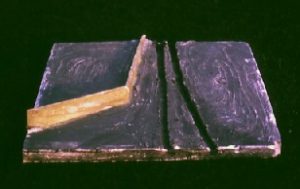
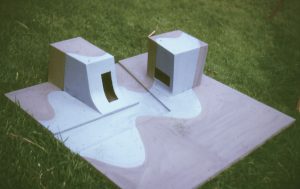 I didn’t think much of it at the time and certainly didn’t show it to anyone (not that I had anyone of any significance to show it to). I find myself reacting to it quite fondly now. I like its simplicity and its immediacy as well as the simple statement it attempts to make about the way we visually connect with and represent the world.
I didn’t think much of it at the time and certainly didn’t show it to anyone (not that I had anyone of any significance to show it to). I find myself reacting to it quite fondly now. I like its simplicity and its immediacy as well as the simple statement it attempts to make about the way we visually connect with and represent the world.
Another surviving image is of a curious little construction. It was inspired, I think, by bus borne visits to the local ordinance factory, a truly enormous site dotted with camouflaged buildings with mysterious, concealed doorways that you could never quite see into. I have less affection for this piece though it has some significance in the light of what came later.
I started, in my workaday travels, to become fascinated by street signs. There was something about these simple graphic representations of what lay ahead that I found intriguing. But why, or how they could be incorporated into some kind of art work, I had no idea. So, I decided to do what several of my lecturers had always advised – advice I had rarely taken whilst under their tutelage – and did some drawing. It was probably the most important decision of that era of my artistic life – perhaps not just that era.
I used layout pads for the main part – those books of flimsy paper used by graphic designers. I used them because they were cheap. And that allowed me to scribble and sketch without worrying about the price of the paper and, therefore, without being intimidated by it.
And, as I travelled around, gazing through the front window of my bus, I drew in my head as well.
What emerged from all this drawing, looking, and pondering was the realisation that these signs were only really interesting in situ. It was their context which gave them their appeal. I became fascinated by the way in which the road down which we travelled was represented, its configuration predicted, by these simple diagrams. Crossroad, bendy roads, T-junctions and roundabouts were all preceded by little black on white, red bordered, variously shaped pictures.
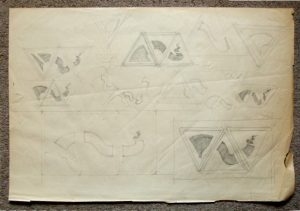
This flimsy A1 sheet was typical of the many I produced during that period, along with more worked up drawings on better quality paper (See Illustrations below).
The drawing bottom left became the chosen version
And I ended up with a street sign of my own. The object itself is long gone along with any direct photographs of it, but it is fairly easy to reconstruct from the drawings.
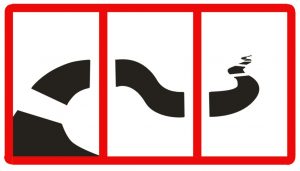
Computer mock up of ‘Road Sign’ painting.
It was painted, using gloss paint, on hardboard, with a recessed support on the back meaning it stood proud of the wall. Unlike the real street signs it combined the bird’s eye view schematic of the signs with conventional perspective, using the broken white line in negative to marry the two together. It was, in other words, two pictorial conventions combined in a single image.
This piece was, actually, an enormous breakthrough. I understood it in a way which I had never done any previous creations. And importantly that understanding was the result of a lengthy period of investigative drawing – both actually and mentally. The question of whether it was any good or not was, in a way, irrelevant. It was the Eureka moment made real. Of course I thought it was good. No artist, be they Sunday painter, Royal Academician or Turner Prize hopeful, can struggle to a personally successful artistic conclusion without believing the product has merit.
Below are just a few of the many, many drawings, mostly on cheap graphics paper.
Back To Contents.
Space(s)
In the meantime, the buses, with me chatting to the driver and watching the world go by, continued to crisscross the county. And what my gaze began to increasing fall upon was the then (and still) ubiquitous JCB diggers.
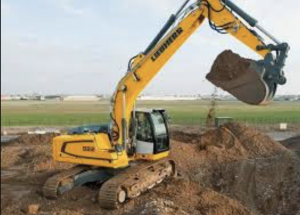
I found these yellow mechanical dinosaurs fascinating. And they offered more sculptural possibilities than the street signs. But it was by no means obvious what that sculptural form would be.
>It was here that the experience of my struggles with the street signs came to the fore. That had taught me of the (personal) need to search for the essence of my attraction to an object or physical phenomenon. And it had also given me the method of finding it – drawing, drawing, and more drawing. (See below)
What started to emerge is not what you might expect. I don’t know whether it was the effects of all that time in the artistic sharp end at Manchester (confusing though they were), the result of the drunken conversations with my tutors maybe, or just me, but I rejected the obvious sculptural attractions of these mechanical beasts – their power and dinosaur like menace. For whatever reason the results of my manic drawing sessions and bus borne ponderings was an increasing interest, not in the giant metallic, hydraulic driven machine itself but the connection it created, between the man in his little glass sided box, to the hole he was creating in the ground. It was the relationship of those two spaces that I found most intriguing, so much so that, by the time I finally committed myself to an actual structure the digger had disappeared altogether.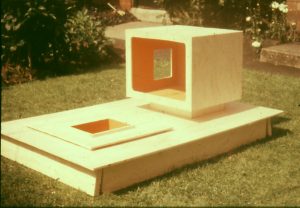
In fact, in the second piece, one of the spaces had disappeared too as I became simply interested in the relationship between internal and external space.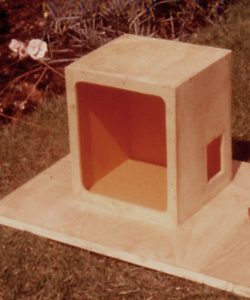
This was exotic stuff. Here, on my own, in the little town of Chorley, in the mid to late sixties, without another artist in sight I was discovering a kind of minimalism. Of course I didn’t know I was and if a real minimalist had wandered by I’m not sure how I would have reacted – probably badly. But one didn’t and I carried on in total ignorance of such things. I was conscious that the people who were around me – my long suffering, non artist wife and our equally non art savvy friends – were completely mystified by the wooden constructions I was busily producing (“And you say it started off as a JCB digger…?”). It is perhaps because of this that, in some of the photographs I’ve added arrows, and in one a small cut-out silhouette of a figure. It was, I think, an attempt to make them more accessible, as in “imagine wandering through this space,” or “think of the movements through or past it.”
Looking back I wish, in pure artistic terms, that I’d had the understanding and/or confidence to make them even simpler.
In one final, finished structure the internal space spilled out to become a flattened two dimensional area. This was a relationship I would explore more fully, and a lot less minimally in years to come.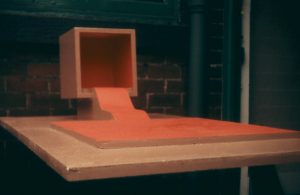
Not that it mattered in the larger scheme of things because I made no attempt to exhibit them anywhere, in fact some of them weren’t even finished or properly stuck together; I merely photographed them (very badly more often than not) and then pulled them apart in order to re-use the wood. My sole goal was to understand, along with some vague, naïve and completely unrealistic notion that, once I’d gained that understanding, I could become one of the art college lecturer gods.
Arrows
In the meantime I continued to draw. The surviving drawings show a continuing interest in roads and their signs and symbols and it was one of those symbols that began to dominate: the arrow.
The humble arrow symbol is a powerful pictorial device. Consisting, at its simplest, of no more than three lines, fattened out to a triangle and a rectangle to make a shape, the arrow exerts an irresistible response from us. Our attention is directed by it. We may not wish to follow the orders it gives us but we can’t help registering its message.
It’s easy to write that now. At the time I just responded to the stimulus as every self respecting artist should. I drew, on paper and in my head, searching for a form or configuration that would crystallise the way I felt about this potent little visual artefact. I came up with the construction which I’ll call ‘3 Arrows’ (none of my work ever had titles at the time)
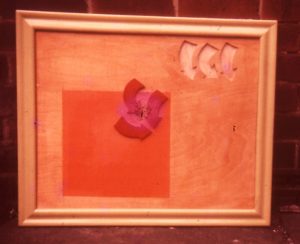
Degraded photograph of actual piece.
I have enormous affection for this little relief construction (it’s about 60 cms wide). It decorated the chimney breast in our little terraced house for several years.
I later produced a second arrow construction. This consisted a very large black arrow pointing down to a box containing other, smaller arrows cut out of wood and painted red. This piece graced the bar of Chorley Teacher Training College for a few weeks after one of their students saw it at my house. The other students used to play with the bright red, wooden arrows from the box apparently, creating routes hither and thither – from where to what and indicating what I never knew, but was delighted that they did.
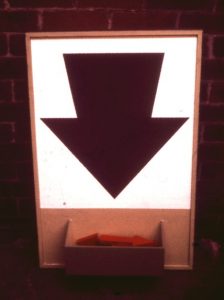
I think this piece came quite a bit later than the ‘Three Arrows’ piece though it attempts to do the same thing. I felt then that it was more successful, and still do. In a way it was unfinished business. The ‘Three Arrows’ piece almost worked; this one did.
It was exhibited in Chorley College canteen, before I was a student there, thanks to a someone from the college who saw it at our house.
Pipes
I had, by this time, moved from bus conducting to working in the office of a large, local rubber factory, a company that made everything in rubber from conveyor belts to hose pipes, tubing to O rings, floor tiles to twenty-thousand-volt-proof switchboard matting. Not that any of these objects or materials entered into my artistic consciousness for the simple reason that I didn’t really have any contact with them. I worked in the sales office, pushing paper for the most part. However, this is not to say that the factory environment didn’t provide any stimulus. I did walk around the ramshackle group of buildings that comprised the factory on a regular basis, to ask this foreman or that what had happened to the order for fifty thousand grommets, which I’d passed to him four months ago. But it wasn’t the grommets that intrigued me (he hadn’t got around to manufacturing those anyway) but the maze of pipes which ran here, there and everywhere else.
And they were everywhere. They emerged from the walls at seemingly random points, joined several of their fellows to hug the brickwork for one yard or twenty, perhaps pass across a gap to another building, and disappear into some other wall, or at another point in the same wall. I found them fascinating.
So, back at home, I drew pipes.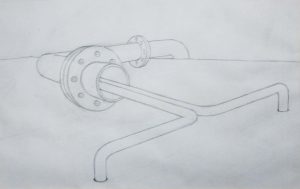
Typically by now it wasn’t the intricate patterns and complex weaving that I found really interesting – exciting and beautiful though these were. What emerged, through the now familiar process of paring away the clutter, was something else. And it was encapsulated in the final drawing in the sequence; three simple sections, connected to nothing but each other with the inevitable arrow and the word FLOW painted on it.
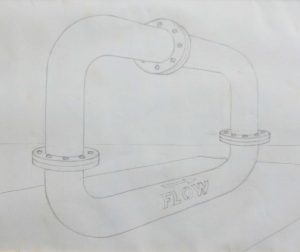 What was really fascinating about these long cylindrical conduits was their mystery. To the uninformed observer that I was, there was no indication as to what they were conveying, from where, to where or in which direction.
What was really fascinating about these long cylindrical conduits was their mystery. To the uninformed observer that I was, there was no indication as to what they were conveying, from where, to where or in which direction.
I never made this sculpture, or any of the other pipe configurations I’d committed to paper. I had neither the expertise nor the money to do so. And, if truth be told I was growing disillusioned with making things that either took up space I didn’t have, or were pulled apart or discarded once photographed. I also hated the job. God how I hated that job.
It was time to look elsewhere.
I had always resisted the idea of secondary school teaching for the rather grandiose reason that it would ruin me as an artist. It’s actually almost embarrassing to write that sentence, given the abject failure of my attempts to become an artist at art college. And there is, I suppose, an irony in the fact that I did begin to contemplate it once I had finally started to find my artistic feet.
In truth I wasn’t really committing myself to a life in teaching when I endeavoured to join the local college of education. What I was really hoping for was three years of being an artist in a place with lots of facilities and people of like mind. The fact that I might end up with a teaching qualification was by the by.
Having said all that, getting myself accepted and supported for three years was no simple, and definitely no easy, matter. It took well over a year of letter writing, waiting in outer offices and meeting a lot of rejection. But the thought of spending another forty years in the offices of that rubber factory focussed my mind considerably. I had nowhere else to go so I went on pushing. And I did eventually succeed.
But before that, in between all the writing and pushing, I continued to produce art work.
Back To Contents.
Roads and Houses
I may have left the mobile viewing platform of the bus but I still made a twenty-five minute journey to work and back each day. The roads continued to fascinate but were now joined by another common feature of the urban landscape; the house.
In fact it was one house in particular which caught my attention first. It was small and square, isolated from it’s neighbours and surrounded by a relatively well kept lawn, broken only by a path to the front door.
This path also circumnavigated the house separating lawn from the house in a metre wide strip.
Needless to say I drew houses. A selection can be seen below.
What emerged, after a good deal of exploration, were a series of sculptural landscapes containing houses and roads. In these the latter floated free above the well anchored house. Once again I failed to turn the drawings into three dimensional structures, until the final one, the drawing for which, more or less coincided with my entry into Chorley College of Education.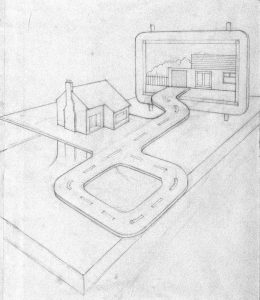
Back To Contents.
Chapter 3 – Chorley College
Luther Kenworthy sounds like a cross between a modern movie villain and the dupe in some Elizabethan conspiracy. He was actually the principle of Chorley College of Education in the nineteen seventies. I never met or even saw him during my three years there but was more than conscious of his effect on the institution he ran.
Luther believed in freedom.
Nothing was compulsory at Chorley College of Education; it was a case of ‘anything goes.’ And it’s fair to say that an awful lot did. It was a mature student college and almost all of the students were on a second educational chance. They consequently tended to take a positive attitude to Luther’s freedom. Many played hard – some very hard indeed – but most worked hard too.
Those who had chosen Art as their main subject brought a wide range of skills and experience with them. There were a small number who could boast at least a taste of art college education, others for whom Art had been no more than their favourite subject at secondary school. The mix was further enriched by the fact that all three years worked together in a single group. This was possible because there wasn’t anything resembling an actual course – just space, facilities and time, a combination much appreciated by most, though not all, the students.
There was a tutor, called Edmund. Edmond was a fantasist, one of those individuals who had told and embroidered his crop of personal anecdotes so many times that they had lost all connection with any form of reality. Many involved the physically impossible, like his claim to have spent a whole night hanging by his hands from a stage set – he had been painting late into the evening and his ladder had slipped from beneath him. All these anecdotes were quickly told to new students by older ones, meaning that, by the time you got them from the horse’s mouth it became difficult to keep a straight face.
My own attitude to Edmund was ambivalent anyway. If I’d reached one conclusion in the preceding six years, it was the importance of making my own artistic decisions. It wasn’t that I was still wary of lecturers or tutors, or even dismissive of them, simply that I saw myself as better off without them. Looking back at myself and the work I produced during that period it seems obvious now that I was ready for some expert mentoring. Unfortunately, Edmund wasn’t the one to provide it. Apart from his tenuous grasp on reality he was also something of an artistic traditionalist. The only piece of artwork I saw him produce during my three years at Chorley College was a very accomplished watercolour landscape, produced in situ on one of our Mains Week sketching trips to Cornwall.
My memory of what kind of artwork my fellow students produced in that first year is once again woefully incomplete but suggests that it too tended towards the traditional. Landscape and still life predominated with occasional forays by some into abstraction.
But whatever the subject and style, those who could get on with it did, and Edmund was happy to let them.
I got on with making my Extended Suburban Landscape.
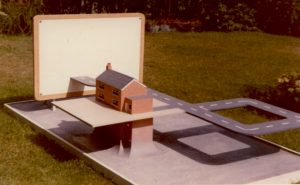
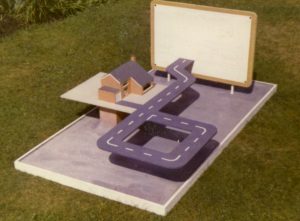
Looking back I find myself wondering what my fellow students made of this strange construction. For many, it couldn’t have fitted in with what they understood to be art. But it did for others, particularly once I’d explained how it encapsulated my feelings about suburban landscape and combined those with my recurrent fascination with various two dimensional representations of a three dimensional reality. (I was learning to talk a good artwork by the stage). It also helped that I could draw a bit too.
I carried on working – in between Education seminars, Secondary Science sessions (my second subject) and various other bits and pieces. I made the ‘4 Roads’ sculpture
followed by a small piece I’ll call ‘Curved Form with Shape’- I don’t remember its contemporary title – it could have been ‘Curved Form with Shape’.
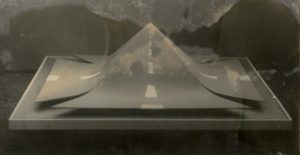
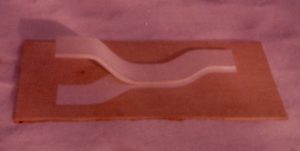
This turned out to be the last of the landscape based sculptures.
Photography (and Action Man)
I now discovered photography – and my five year old son got an Action Man for his birthday. I think the photography came first.
The Art Department had a dark room. Not only that, it had a seemingly inexhaustible supply of materials. Which is just as well since, incompetent photographer that I’ve already admitted to being, I ruined more paper than I usefully developed. This technical incompetence was to bear its own fruit later but for the time being it was just part of the learning process. Of course, incompetence apart, the big question was, what to photograph? It was somewhere around this point, I would guess, that Action Man entered the picture.
Surrounded as I was by students busily attempting to represent reality in pencil and paint, some with freedom and style, others with varying levels of difficulty, my own fascination with representations of, or substitutes for, the real – begun with that first traffic sign painting – resurfaced. Or, to put it another way, and one which better accords with my actual, if moth eaten memory, I began to play with Action Man, with my camera and with the exciting facility of the college dark room.
‘Play’ it might have been but it raised some interesting questions. Action Man was real, wasn’t he? Ok, not ‘he’ but ‘it’ – Action Man was a real doll. But it was still a representation. But what of? A human being, a person, an idea? A photograph was definitely a representation but was it more real than a drawing? Was it more real than the doll? Where did a photograph of the doll fit in? And what about scale?
I did make one attempt to search for some insight through drawing, by superimposing an image of Action Man on an image of an office.
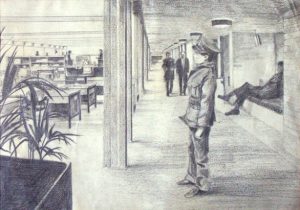 It didn’t do very much, and not only because Action Man is out of scale with the environment – he hasn’t been scaled up enough.
It didn’t do very much, and not only because Action Man is out of scale with the environment – he hasn’t been scaled up enough.
Drawing obviously wasn’t the right exploratory tool – it took up too much time given the level of detailed realism involved. The camera and the darkroom took over the role of the sketchbook.
I took some photographs of the little doll connecting with various ‘real’ objects and printed them off life size. I assembled and photographed one little tableaux several times.
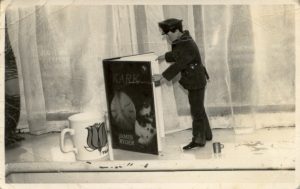
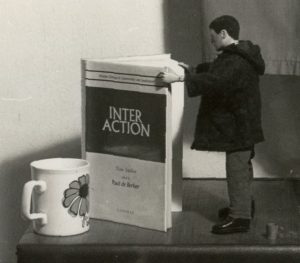
I wanted, though, to introduce some additional two dimensional elements into the mix. I first took a photograph of his head and blew that up to human size. And then I got someone to take some photographs of me, blew those up to Action Man size, stuck them on some stiff cardboard and cut them out. And then, of course, I continued to play. The eventual result was ‘Meeting’
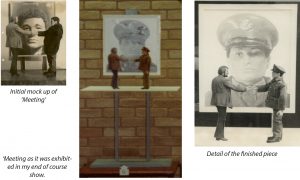 We had enjoyed our brief relationship, Action man and I. (That he enjoyed it is without doubt – the whole point of dolls is that they think, act and feel how you want them to act, think and feel). But now, my five year old son, Rupert, decided that it was time for Action Man to concentrate on what he was designed for, i.e. killing imaginary foes and causing general mayhem. In other words, Rue wanted his birthday present back.
We had enjoyed our brief relationship, Action man and I. (That he enjoyed it is without doubt – the whole point of dolls is that they think, act and feel how you want them to act, think and feel). But now, my five year old son, Rupert, decided that it was time for Action Man to concentrate on what he was designed for, i.e. killing imaginary foes and causing general mayhem. In other words, Rue wanted his birthday present back.
It was time to move on anyway. Deciding where to go was easy. I was now hooked on photography.
Girl
This is not to say I became obsessed with f stops and exposure times, or had a desire to emulate Cartier Bresson or Robert Capa (my recent dalliance with a soldier notwithstanding). I brought a sculptor’s eye to the subject, or my sculptor’s eye at any rate. Sounds crazy, I know, but it’s true.
One of the ideas that the Manchester Art College sculpture department had engraved onto my psyche was that the form of a sculpture is (or should be) as influenced by the material it’s made of as it is buy its subject, if not more so. Michaelangelo gave this notion a boost long ago, of course, when he said that “Every block of stone has a statue inside it and it is the task of the sculptor to discover it.” In the early seventies the American Marshall McLuhan (who’s first name, I have only recently discovered, was Herbert) took this idea to a new extreme by suggesting that the medium was the message, not least in his best selling book The Medium is the Message: An Inventory of Effects (1967).
Fired up by these notions I didn’t take photographs of things, people or views, I took photographs of photographs. And then I went into the college darkroom and used my far from expert technical skills to develop the results.
The subjects of these experiments where usually images from magazines. The effects of translating them into simple black and white snapshots were fascinating. An image of an anonymous model in a magazine was public property, no more than an attractive clothes horse; in snapshot form it became the image of an acquaintance – or so it felt. I decided to choose a single image and explore further.
It was here that my poor darkroom skills became temporarily advantageous. Mistiming the development time changed the image again, failure to focus the enlarger properly and a different feel resulted. The product of these accidents and subsequent explorations was a series of images and objects which, in my end of course show, I simply described as ‘Girl’.
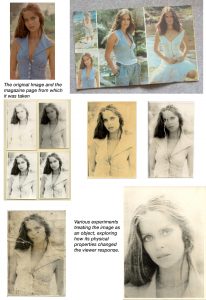 I saw the artwork then as the full collection of experiments, albeit with some pieces picked out for special treatment. But then it was an end of course show, laid out for assessment, sketch books and other preparatory material included. If one piece was the final, stand alone, artwork it was ‘Family Portrait – Identity Withheld’ This is a modern title – it didn’t have one at the time.
I saw the artwork then as the full collection of experiments, albeit with some pieces picked out for special treatment. But then it was an end of course show, laid out for assessment, sketch books and other preparatory material included. If one piece was the final, stand alone, artwork it was ‘Family Portrait – Identity Withheld’ This is a modern title – it didn’t have one at the time.
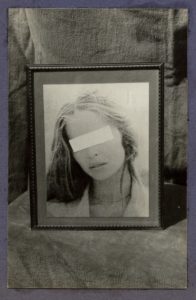
The original piece as exhibited at the time.
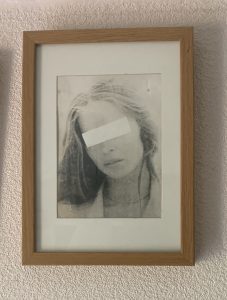
where it lives now, in a modern frame on the wall of our box room.




 It didn’t do very much, and not only because Action Man is out of scale with the environment – he hasn’t been scaled up enough.
It didn’t do very much, and not only because Action Man is out of scale with the environment – he hasn’t been scaled up enough.

 We had enjoyed our brief relationship, Action man and I. (That he enjoyed it is without doubt – the whole point of dolls is that they think, act and feel how you want them to act, think and feel). But now, my five year old son, Rupert, decided that it was time for Action Man to concentrate on what he was designed for, i.e. killing imaginary foes and causing general mayhem. In other words, Rue wanted his birthday present back.
We had enjoyed our brief relationship, Action man and I. (That he enjoyed it is without doubt – the whole point of dolls is that they think, act and feel how you want them to act, think and feel). But now, my five year old son, Rupert, decided that it was time for Action Man to concentrate on what he was designed for, i.e. killing imaginary foes and causing general mayhem. In other words, Rue wanted his birthday present back. I saw the artwork then as the full collection of experiments, albeit with some pieces picked out for special treatment. But then it was an end of course show, laid out for assessment, sketch books and other preparatory material included. If one piece was the final, stand alone, artwork it was ‘Family Portrait – Identity Withheld’ This is a modern title – it didn’t have one at the time.
I saw the artwork then as the full collection of experiments, albeit with some pieces picked out for special treatment. But then it was an end of course show, laid out for assessment, sketch books and other preparatory material included. If one piece was the final, stand alone, artwork it was ‘Family Portrait – Identity Withheld’ This is a modern title – it didn’t have one at the time.
The original piece as exhibited at the time.

where it lives now, in a modern frame on the wall of our box room.
Cutout Figures
I was now at the end of my second year. My third began with a move to a brand, spanking new, custom built college on the edge of town. At least we thought it was custom built until we discovered that the Art Department had a low black ceiling and Chemistry steel sinks (just watch that nitric acid burn straight through). The latter didn’t effect me because I’d finished with second subject Science at the end of year two.
So there I was, in the new, spacious but low ceiling Art Department, facing a final exhibition in a few months time. I don’t know if this was a factor in my decision to go large and dramatic but this is what I did. I decided to see what would happen if I scaled up an image of someone to real person size and get rid of the background, thus reducing as many of the differences as possible between the two dimensional image and its subject.
It’s tempting to suggest that it was modesty that stopped me scaling myself up. In fact I wanted something more potent. I came up with the idea of a naked female – as artists, particularly male artists, have tended to do since the dawn of time. And, for reasons of cost, copyright and the unavailability of a suitably willing and attractive model, I was going to have to paint her, from an existing photograph. The source was obvious. If ever there was a group of images which acted as substitutes for the real thing it was the naked young ladies in girlie mags.
The research for this project wasn’t I admit, particularly onerous, once I’d overcome the excruciating embarrassment of acquiring the necessary materials. The image I needed, though, had to fulfil fairly exact parameters. It had to be of a complete, standing figure, photographed from a low to mid level viewpoint with a longish lens. I found an image which fit these criteria and set about reproducing it life size in paint.
I soon encountered difficulties, largely emanating from the fact that I hadn’t painted in a photographic style since I was sixteen.
The fragments of recollection that I insist on referring to as my memory has me painting an oversize hand for some reason (possibly a precursor to the figure) and failing miserably. I do remember painting a single finger or thumb after that in order to relearn the technique.
Eventually I developed the confidence to paint the first pinup girl (1st image below).
I had reached the conclusion that this image was a bit too powerful in its enticing sexual provocation (I was at a teacher training college after all) but probably, more importantly, she wasn’t as well painted as I would have liked. So I painted Eve.
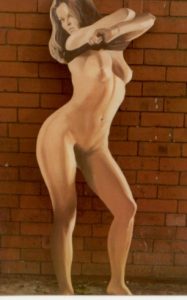
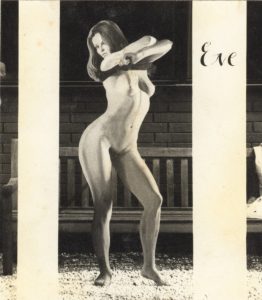
She was slightly more subtle as a sexual provocateur – though not subtle enough, it later turned out .
I was never completely happy in giving her a name, incidentally, since it threatened to upset the balance between object/image and person that the piece was supposed to be about. It had the danger of sending the bias too far towards the person and in a way that I didn’t want in the equation at all. But when I added the two white rectangles, the name became useful in helping them read as the borders of a magazine page.
I was, by this time, an obsessive leafer through magazines of all kinds, on the look out for low level, long lens images of complete figures, and it was in one of these, a then three year old Sunday Times colour supplement that I discovered the image of the artists Gilbert and George.
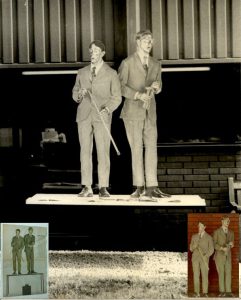
B & W photograph of the cutout painting with colour insert (right)
and original magazine page (left)
It offered the perfect subject for another cut-out painting, Here were two artists presenting themselves in the gold painted flesh as a living work of art, and yet I could only experience them through a small, two dimensional image. What a hoot to take them part way back to the original by transforming that image into a life size cut-out. We even had the same style of table in the college refectory for them to stand on. Several weeks later and Gilbert and George were partially reborn and standing on a table liberated from Chorley College canteen.
Well, I thought it was hoot anyway.
And then, before we all knew it the end of course show was upon us and I got to exhibit the work I’d done in the (new) college entrance hall.
This, amazingly it seems now, was the first time I’d had an exhibition. In fact, with exception of the Big Arrow piece in the college bar, which I’d never seen in situ anyway, I’d never exhibited any work at all – as an NDD student at art college I was assessed by exam not display. So being able to assemble the work I’d done over the last few years, work that I now felt confident about, was really quite wonderful.
And I got a top grade (A – there being no pluses or stars in those simpler days). I’d also got rid of the large F that art college had stamped on my forehead. I was an artist.
But I was an artist with a wife, two children, a mortgage, and no job.
Where next?
Back To Contents.
Chapter 4 – Vernon Gallery
Some fifteen years after the events described below I happened to take a nostalgic wander through my old slides. I don’t remember the reason, or even if there was one, just the unhappy discovery that one box contained mainly blanks. Some kind of microbe or chemical had eaten all the images leaving nothing but clear little windows. The main visual record of several years’ production was gone forever. The narrative which follows is therefore based on fragments of drawing, a few objects but too often unaided memory. The illustrations of it are, needless to say, also a bit thin.
“Those who can, do. Those who can’t, teach,” said George Bernard Shaw in 1903. Lots of people at Chorley College were still saying it in 1975, usually adding …”and those who can’t teach, teach teachers.” I was inclined to go along with both versions but accepting the original left me in something of a dilemma. I’d just spent nine years proving, to my own satisfaction at least, that I could do. And since my one session of teaching practice in a secondary school hadn’t exactly inspired me with enthusiasm, I wasn’t sure I wanted to sew leather patches on the elbows of my jacket just yet (I didn’t have the right kind of jacket for one thing).
Yet what else was there?
There was no way I was going to break into the art world and make my fortune. Not from Chorley. And not with my personality. The attitude that had held me back so disastrously at art college – my deification of the teaching staff – still operated double with regard to the art world. And given my inability to interact with anyone I haven’t been introduced to (and, better still, imbibed alcohol with), even if I’d known where the art world lived I was psychologically incapable of approaching it. The only route to it that I could conceive of was via the art college system, by becoming a lecturer. But that was equally unattainable. I was under no illusions; even a top grade from a teacher training college carried about as much weight as a cycling proficiency badge to an art college.
So with some reluctance I consulted the pages of The Times Educational Supplement.
There were two Secondary School Art Jobs within travelling distance – both in Preston. The first, Ashton High School, wanted someone to teach Art for one year, the other, Tulketh High School, wanted an Art specialist to teach Art and something called Creative Design. So, as my wife and children looked on, their empty soup bowls clutched hopefully to their chests, I applied for both.
Of the two I wanted the Ashton job, because it was temporary. Another character flaw I suffer from is inertia – I was worried that once I got into a school I would never get out again (spot on there Stuart). At least with this job I would be forced out after a year, during which period I could have a good look at the alternatives. In addition, I had absolutely no idea what Creative Design consisted of. I got interviews for both, on consecutive days.
I didn’t get the Ashton job.
I arrived home afterwards feeling a bit miffed. Actually, I was bloody furious. Who did they think they were? I didn’t even want to be a teacher. They could stuff their so called profession. There was no way I was going to the Tulketh interview tomorrow. Sod ‘em.
But when I woke up the following morning, there were the little ones with their soup bowls again. Ah well, I decided, I might as well go and have a look. What harm could it do?
On such tiny pivots does life occasionally revolve.
I almost blew that interview too. In fact, had there been another candidate I almost certainly would have. But there wasn’t. Goodness knows why – perhaps nobody else knew what Creative Design was either, or maybe, more worryingly, they did.
But the headmaster and his Head of Art did decide to take a chance on the one bumbling idiot who had turned up and I was able to return home and inform the little ones that come September, their bowls would be full once more. We might even be able to afford bread to dip in the soup.
I was actually quite excited by the prospect of joining the Tulketh Art Department. It was staffed by two youngish males, both called John. McKay was head of department, Bevan his assistant. They both had a sense of humour and John B in particular was a committed, working artist. (John M, as far as I recall, preferred to go fishing).
Creative Design, I discovered, represented John M’s attempt at empire building – by expropriating some of the activities of Boy’s Handicraft into the Art Department. I was to be his fifth column in this endeavour, using the facilities of the Woodwork room to help first years make objects d’art instead of teapot stands, or at least better and more individually designed teapot stands. Needless to say, I wasn’t welcomed with open arms by Bill and Rod, the two traditionalists who worked there, particularly when they found out I had no woodworking skills to speak of. The saving grace was that the room was only free for a couple of the four or so lessons I was timetable to teach. I taught the rest in a small room near the Art Department. It wasn’t much bigger than an office (it was turned into one in later years) but it didn’t have Bill and Rod peeking into it from the stockroom so I preferred it.
As will be obvious from the above, my fifth column, Creative Design activities took up only a small part of my teaching timetable. So too, sadly, did Art. For the rest, well over half, I taught Technical Drawing – in the Dining Hall. This was another subject I knew nothing about. As so many teachers have done before me, I just stayed one week ahead in the textbook.
And whilst I spent my weekdays wrestling with the concepts of First Angle Projection, doing my best to placate Bill and Rod, juggling the cardboard boxes that were my mobile storeroom, and defending myself from the attempts of the pupil population to destroy me, in the evenings and at weekends I carried on being an artist.
I also began socialising with John Bevan.
John and I got on well. We had, it turned out, a lot in common: we had both failed to take advantage of art college opportunities, both recovered ourselves through teacher training college and both felt defined by our continuing engagement with art. John, it must be said, was a very different artist from me. His artistic hero was Roger Hilton and his paintings reflected the fact.
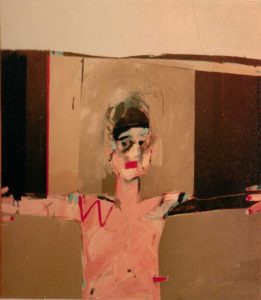
Painting by John Bevan. Title unknown – his titles changed every time he exhibited them. Not sure about the colour either; it’s from an old slide.
I was still wandering about in the margins between drawing and painting, photography and three dimensional ‘reality’.
Without the space and facilities that Chorley College had offered the scale and scope of what I could produce was now much more limited. I did manage to create a makeshift darkroom in our little bathroom but there was no way I could overcome the lack of space. So life size, cut out paintings of figures, naked or otherwise, where out. I began to work on a much smaller scale.
Given the scarcity of visual reminders, it’s difficult to get the chronology right but what I am sure of is that the work followed two tracks: small cut out, free standing drawings of figures being one; an exploration of real objects, three dimensional drawings of those objects (explanation below), and areas in between, being the other.
A couple of the cut out figure drawings survived though not the structures they were displayed on.
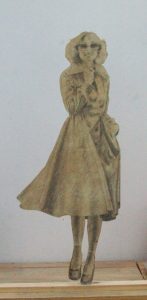
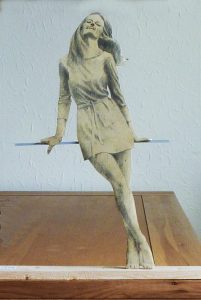
Recently taken images of these figures give a flavour of how they worked. At the time I had slight reservations about the trickiness of some of them. This is exemplified by the leaning figure. My main concern, at the time, was that the tricksy, ‘gravity defying’ aspect of this image/object distracted from the important activity of exploring the interface between image and object, drawing and photograph. These days I like this tricksy element for its playfulness.
In the main, these cut out figures (there were, my imperfect recollection suggests, about half a dozen of them) were displayed on simple shelves with wooden backgrounds, though in at least one case the ‘shelf’ was angled downwards and wider at the front, giving it a false perspective. The figure in the one I remember was a bather emerging from the sea and the horizontal wood grain worked as the rippling water. I liked the way the actual texture connected with the image and took on the role of representing something other than itself.
In another variant the back board was a mirror. On the reverse of the cut out drawing I drew the image in reverse. Seen through the mirror this drawing was therefore the right way round. The spectator could thus see two images of the same figure: the cut out itself and a mirror image that wasn’t a mirror image behind it. I’ve been fascinated by mirrors on and off ever since.
As I have by grids. I had used graticulation, to use a posh term for it, to reproduce these and earlier photographic images and I now began to explore their potential. Spending as much time as I did looking through magazines in search of suitable images I became conscious of the various kinds of effects that different camera lenses produced. In the main I was searching for complete figures photographed with longish lenses but also encountered the opposite; wide angle images. Had I had enough money I might simply have bought a selection of these optical devices and gone out to experiment. Or maybe I wouldn’t; to be honest I enjoyed the challenge of creating a wide angle effect from an ordinary photograph using distorted squares. (I later became besotted with the humble grid distorted or otherwise. It came to dominate my artwork and my teaching. But I’m getting ahead of myself.).
At the same time (I think) I began to explore the 2D/3D, drawing/photograph/object interface from the opposite direction, by giving objects some of the qualities of images. It was largely still a black and white world back then. Although colour photography and reproductions had been around for a long time it remained expensive and most images, personal and public were in black and white. So simply making a piece of packaging ‘grayscale’ to use modern parlance (and spelling) was enough to move it closer to a two dimensional representation.
So I did, choosing, as subject, the then ubiquitous No. 6 cigarette packet, an example of which was never far from my elbow or pocket in those smoke filled days. I pulled open this familiar piece of packaging, flattened it out and reproduced it in pencil on clean white card. The result was then folded and glued to become a three dimensional drawing of sorts. I added a box of matches (with real matches painted grey) and set them on a piece of paper, on which was drawn a fake piece of paper visually held down with a pencil rendered drawing pin.
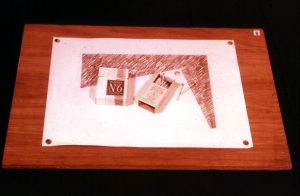
I then went on to make the Police Car piece, painting a model car grey and placing it on photograph taken from a suitable office block. This was the photograph to the No.6’s drawing.
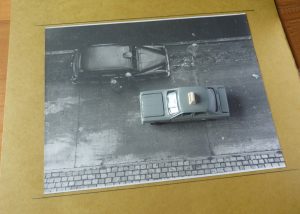
John meanwhile, had gone and got himself an exhibition at a local gallery. This was the Vernon Galley, an attractive and prestigious exhibition space connected to and financed by a local graphics firm. When he applied for the exhibition it had been suggested that, even if he was accepted, it would be over a year before a slot became available, thus giving him time to build up a body of work. As it turned out they had a cancellation and offered him a slot only weeks away. Enter Stuart to help fill the space.
I’m not sure if John regretted asking the Vernon Gallery if I could share the exhibition, but I’m fairly sure that the Vernon Gallery regretted agreeing to it. But we’ll come to that in a minute.
In truth I’m not absolutely sure when exactly they did agree. Deeper reflection suggests it happened in the middle of the artistic production described above and acted as a driving force behind much of it, particularly the number of cut out figures. It certainly happened before the production of the HP bottle sequence. This turned out to be a major piece in my part of the exhibition since it took up a whole wall. It consisted of about eight HP bottles and images of same in various mixtures of representation and acuality. Annoyingly the only images which survive of this sequence are the really boring ones at the extremities of the sequence.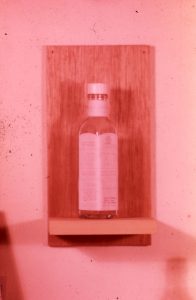 The originalsequence, as far as I remember it, was: 1. empty bottle without label, 2 .empty bottle with outline label (Illustrated left), 3. drawn cut out, 4. bottle with fully drawn label filled with grey powder, 5. bottle with black and white photographed label filled with grey paint, 6. painted colour cut out, 7. bottle with painted label filled with brown paint, 8. unopened bottle of HP sauce. There could have been a cut out photograph in there too but I’m not sure.
The originalsequence, as far as I remember it, was: 1. empty bottle without label, 2 .empty bottle with outline label (Illustrated left), 3. drawn cut out, 4. bottle with fully drawn label filled with grey powder, 5. bottle with black and white photographed label filled with grey paint, 6. painted colour cut out, 7. bottle with painted label filled with brown paint, 8. unopened bottle of HP sauce. There could have been a cut out photograph in there too but I’m not sure.
I remember this piece causing a certain amount of consternation, of the “If that’s a work of art, I’m a Martian,” variety. But it wasn’t the exhibit that caused the real problem. That was Eve, the only piece not produced post Chorley College.
It never occurred to me that anyone would object to Eve. She had, after all, adorned the entrance hall of a College of Education a year or so earlier, a place where parties of schoolchildren had even been known to tread. But then Chorley College did have a bit if thing about being open minded. Not so, it turned out, the Vernon Gallery. The day after the private view they removed Eve along with a life sized drawing of a topless girl with her hand down the front of her trousers.
To be fair, I had put Eve in a provocative place. The gallery was adjacent to the works canteen and I had placed my life sized, cut out glamour girl, pubic hair and breasts resplendent, right next to the serving hatch.
Looking back I feel I took it well. In fact I saw what had happened as an affirmation of the piece. I explained this on the A4 typed sheet to which I attached a small black and white image of the missing art work.
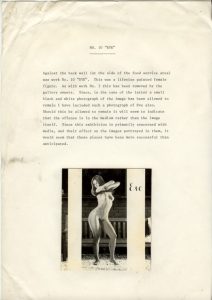 I stuck this where Eve had been.
I stuck this where Eve had been.
There are those who would argue that I should have contacted the local evening paper and kicked up a stink. It never occurred to me at the time; I’m still not sure whether I’m proud or embarrassed by the fact that it didn’t.
I never did get Eve back. Someone did tell me that she graced the draughtsmen’s office for a while. How long a while I have no idea, but was happy she was there being ogled rather than stacked away unseen, warping and decaying, in my damp garage. What happened to her I have no idea. I assume she ended up in a skip though I suppose there is a miniscule chance that some retired architect still has her propped in the corner of his study. I can but dream.
Note. After reading the above, in his idyll in Spain where he now lives, John reminded me of the problems he too had experienced with that Vernon Gallery exhibition. He really had struggled to produce work for the exhibition since he was not only teaching during the day but working as a night-watchman into the early hours of each morning. He did, however, have lots of spare time during his late evening vigils. There wsn’t enough room to paint so he took to making small collages using coloured card. These beautiful little pieces – they were just slightly bigger than A4 – eventually took up a whole wall of the exhibition. Unfortunately, once up in the dry air of the gallery they started to spring into life. Whatever glue John had used proved to be unequal to the task; the cardboard shapes began to curl away from the surface. He spent the evening before the opening frantically gluing them back down again.
(He now claims it was “a bad batch of glue”.)
Below are some additional images. The images of the No.6 package, matchbox and car are modern photographs of the real objects. Both boxes are looking their age. Also exhibited is an image of Eve which has also suffered the effects of time (and whatever bug when through the other slides). I find myself thinking of the young woman depicted the original photograph and wondering what time has done to her.
Back To Contents.

Painting by John Bevan. Title unknown – his titles changed every time he exhibited them. Not sure about the colour either; it’s from an old slide.




 The originalsequence, as far as I remember it, was: 1. empty bottle without label, 2 .empty bottle with outline label (Illustrated left), 3. drawn cut out, 4. bottle with fully drawn label filled with grey powder, 5. bottle with black and white photographed label filled with grey paint, 6. painted colour cut out, 7. bottle with painted label filled with brown paint, 8. unopened bottle of HP sauce. There could have been a cut out photograph in there too but I’m not sure.
The originalsequence, as far as I remember it, was: 1. empty bottle without label, 2 .empty bottle with outline label (Illustrated left), 3. drawn cut out, 4. bottle with fully drawn label filled with grey powder, 5. bottle with black and white photographed label filled with grey paint, 6. painted colour cut out, 7. bottle with painted label filled with brown paint, 8. unopened bottle of HP sauce. There could have been a cut out photograph in there too but I’m not sure. I stuck this where Eve had been.
I stuck this where Eve had been.Back To Contents.
“Being ‘discovered’ is the dream of many painters and sculptors. Well, for two Preston based artists the dream is about to come true. Stuart Mason and John Bevan have created something of a stir with their recent exhibition at the Vernon Gallery in Preston, so much so that there is talk of the exhibition being moved to one of the more prestigious London galleries...”
Alas no. That isn’t quite what happened. If anyone with influence, a media voice or just someone with an inclination to flatter, did see our exhibition they chose not to mention the fact. When the show came to an end we just collected our work (less Eve) and scurried back to our semis in Penwortham (where we both now lived). John carried on painting and I carried on mucking about with photographic imagery. The pace of my production slowed down however.
John had by this time left Tulketh to become Head of Art at Lostock Hall High School where he would eventually see out his career. One consequence of this was that I now had a lot more Art on my timetable. Teaching Art didn’t yet take on the importance in my creative life that it would later do, but it was sufficiently interesting and challenging to suck up some of my creative juices. Add that to the deflating effects of the Vernon Gallery exhibition and periods of inactivity began to creep into my personal artistic journey. I certainly didn’t stop altogether but what work I did tended towards the experimental – just mucking about with photographs and drawings might be a more down to earth way of putting it – but I never really reached the kind of definitive conclusions that my earlier work had done.
I was, quite simply, running out of steam.
And then came the summer of 1981, one of the few moments I can put an actual date to with some degree of certainty. My artistic production ceased altogether. It was a temporary interruption lasting about a year. In short, I took up writing.
I had always written a little – the staff pantomime, humorous reports on staff cricket matches – but nothing serious. That summer, bored and a little disillusioned with making artwork, I embarked on a novel. I bought myself a small portable typewriter and wrote for much of the summer holidays. I had absolutely no idea what I was doing and this, strangely enough, was what I liked about it. I had no history as a writer (apart from the scraps mentioned above), no standards to live up to and nothing to prove. I could just enjoy myself. And I did.
At the end of the six week break I went back to school and the rate of production slowed. It would probably have stopped altogether, never to start up again, if it hadn’t been for a couple of colleagues, one a poetry writing Head of English, the other a Geography teacher with a tendency to quote Shakespeare. I announced to these two buddies one night over a pint that I had embarked on a novel. Neither of them said anything – which was bad enough – but their gazes seemed to wander slightly as if in search of flying pigs. Then they changed the subject. I went away that night a determined man.
It was no small effort and took the rest of year. I wrote in long hand, in pencil, with much rubbing out and alteration. I even physically cut and pasted (well, sellotaped). And then I laboriously typed each chapter up on the portable. The result was a comic novel called ‘Witters’.
Looking back, it’s a flawed book. I was learning as I went along and in the early chapters it shows. Not the first chapter – I rewrote that every time it came back from the publisher with a rejection slip – so that’s not bad. But the few following that are a bit pedestrian. It gets better once it gets going; it’s positively hilarious in places and has an exciting ending.
At the time I only had two copies, the original and a poor quality photocopy. So the relatively good one went off to one publisher at a time, carrying all my hopes and dreams with it, the latter only to be dashed when it came back two months later. But somehow the hope would fill up again, like the energy level in a shoot ‘em up video game, and I’d parcel it up and send it to the next one (after rewriting the first chapter).
In the meantime I went back to Art.
Not that I abandoned writing for good. The dream of getting published may have faded but the pleasure I got from the process of writing itself remained; particularly from writing a novel. During the year that it took me to write a book length work of fiction I had two lives running side by side: a real life and a fictional one. And in the fictional one I got to play god.
So in amongst the work described in the following chapters I continued to write, on and off. Three more novels followed over the years. I loved writing them. the middle two are on Kindle. I neither recommend nor renounce them. They’re just there; the digitised remnants of a few years of marvellous distraction.
Below are images of the four books. I unpublished ‘Witters’ , ‘Drawn In’ has yet to be published.
The artwork I produced following that hiatus was very different from the stuff which preceded it. It was more intuitive, more abstract and completely medium driven.
The medium was wood, specifically driftwood collected from the River Ribble, the banks of which I used to walk along whilst waiting for my novel to find a publisher.
Mention driftwood, in an artistic context, and listeners are wont to imagine the exotic natural forms of tree branches and roots, worn grain-revealingly smooth by the actions of the tides, and needing only the merest tweak to turn them into a cute little squirrel or a rampant stallion. It is true that I had used such bits of aesthetically pleasing bric-a-brac in my early teaching (much to the horror of the woodwork teachers whose workshop I was teaching in and with whose precision tools my first year pupils were happily sawing and hacking away at the lumps of half dried out detritus I’d given them). No, the stuff I was personally drawn to was more man-made industrial than nature’s bounty: blocks, wedges and planks to be exact, stuff that had fallen off the decks of passing cargo ships. Preston, in those days, still had a working dock, albeit a dying one and merchant ships still occasionally chugged up and down the river, losing, or discarding, a surprising amount of their contents in the process.
It was the wedges that attracted me first. These were six or seven inch long, triangular sections of wood and littered the river bank along its length. They had obviously been used to stabilise cargo on the decks and in the holds of the ships and boats. They were of uniform size but varied in their colour, grain patterns and condition. I began to collect them. And back at home, in the back garden of our little semi, I contemplated turning them into some kind of sculpture.
I pushed those wedges into all sorts of configurations and juxtapositions, scattered them randomly, sat and gazed at them, and then pushed them around some more. I don’t know how long this process went on for. Memory suggests days. Memory also suggests warm sunshine so I wasn’t physically uncomfortable even if I was artistically. And I did start to get very frustrated as these little wooden wedges refused to turn themselves into a successful work of art, despite their obvious potential.
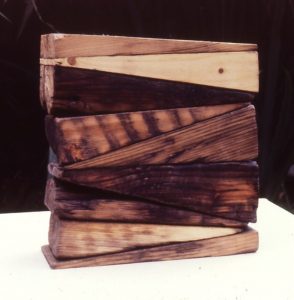
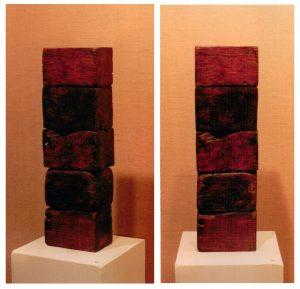 It is tempting to suggest, for the story’s sake, that I finally gave up and stacked the things up prior to giving up. And maybe that is what happened but they did end up in a stack. And suddenly there was my sculpture. It worked. This simple configuration managed to emphasise both their uniformity and their random differences in one single stroke. And it did so with the kind of pared down simplicity that I always found myself searching for.
It is tempting to suggest, for the story’s sake, that I finally gave up and stacked the things up prior to giving up. And maybe that is what happened but they did end up in a stack. And suddenly there was my sculpture. It worked. This simple configuration managed to emphasise both their uniformity and their random differences in one single stroke. And it did so with the kind of pared down simplicity that I always found myself searching for.
I couldn’t have explained it like that at the time, indeed, I didn’t want to; didn’t want to spoil the purity of the relationship that I had with the material. What I did want to do was get back down to the river and collect more of it.
That first, breakthrough piece wasn’t perfect – breakthroughs rarely are in my experience. But it paved the way for much stronger works like the block sculptures which directly followed it. The component parts of the first of these little towers, the actual blocks, had obviously once been parts of pallets, those two tier wooden platforms on which all manner of goods are stacked whilst allowing fork-lift trucks to get their forks underneath, or stevedores their ropes. What they were doesn’t matter of course but the fact of their identical origins and time wrought uniqueness did. And, as in the wedge sculpture, each was emphasised by its juxtaposition with the others. They had, in a way gone through four transformations: natural growth, industrial regularisation, natural degradation in the river and a second return to order in the sculpture.
But at the time they were just beautiful objects and stacking them up seemed to emphasise the fact.
I felt rather good about them anyway. These were, after all, straightforward sculptures born of a simple relationship between me and my material. They needed no explanation, they just were. Of course not everybody who saw them felt as I did. To the philistine they were just lumps of old wood piled on top of one another – anybody could do that. But even to the artistically challenged they were easier to take than an empty sauce bottle. Not that any of that mattered. I just felt good about them.
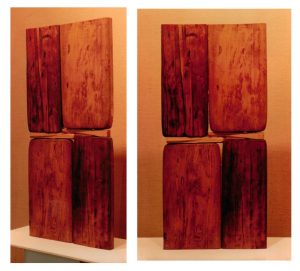
Connection
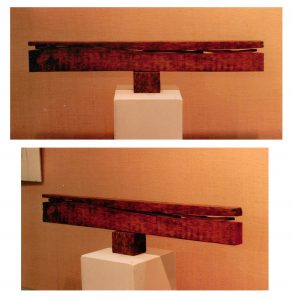
Ripple
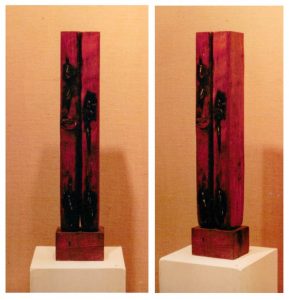
Column(s)
I began to collect larger pieces which I would bring back to my occasionally sunlit patio and contemplate – sometimes for hours. My aim was always simplicity, for a minimum of manipulation. But, increasingly, when simple juxtaposition didn’t work I allowed myself a little alteration – like taking a saw and cutting one of the longer pieces in half ( ‘Column(s)’ ). Or adding a few bits of non-river bank wood ( ‘Ripple’). In ‘Connection’ I did both.
Not all the results were a complete success. Even at the time I had tiny doubts about the piece I called ‘Lift’ (last image below). The problem is embodied in the name. It came too easily, was too obvious. In the earlier pieces I struggled to name them. They didn’t really need or want names and any attempt to attach one seemed to diminish them. But naming them ‘Sculpture 1’ and so forth seemed a cop out so I sought titles which were as devoid of unwanted and possibly distracting meaning as possible. There were some pieces for which I never reached a satisfactory solution, like the piece I call ‘Connection’ for this narrative. This is still one of my favourite pieces for which any name I’ve been able to come up with seems to fall short, emphasising one aspect over another. With lift the title screamed out because the curved wooden slats resembled wings. I didn’t really want any of these sculptural components to represent anything but themselves.
John, meanwhile, had not been idle. He was never idle (and still isn’t – as I write, he’s just single-handedly built a gazebo in his garden in Spain). Not only was he continuing to produce increasingly exciting paintings he was still exploring the possibility of exhibiting them. The result of his endeavours was an exhibition at the local polytechnic arts centre, for his paintings and my new sculpture.
Preston Polytechnic was only then beginning its spread across the town, a process that would accelerate dramatically once it morphed into the University of Central Lancashire. St Peter’s church was one of the early acquisitions. By the time John and I exhibited our work there, it had lost its apostrophe (if it ever had one) and become St Peters Art Centre. It was a good space for displaying our stuff. John’s paintings and drawings decorated the walls whilst my sculpture, on custom built plinths (custom built by the gallery I should stress), took up the centre.
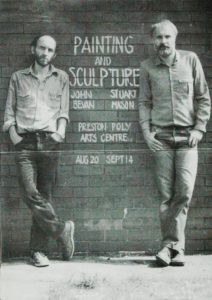
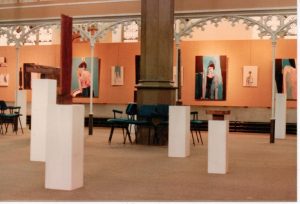
Exhibition at St Peter’s Arts Centre, Preston
With the anti-climax of the Vernon Gallery exhibition still fresh in our minds we set about publicising the event. I took on the task of writing to all the quality newspapers whilst John phoned the local radio station. Needless to say, John was the more successful, getting us an interview with Radio Lancashire. I, when I got a response at all, managed only negatives. Marina Vaizey of The Sunday Times did send us a very nice hand written note offering us her best wishes but regretting that she wouldn’t actually be in the Preston area on the date in question. I added this, and the one or two other regrets, to the folder of rejection letters I was by then receiving from publishers. We also produced a poster.
This was, it should be said, a time of enormous optimism for both of us. I was now a writer and an artist. Not a published author admittedly but I’d only had a couple of rejections at that stage. And now I was exhibiting a new body of art work in a gallery run by the nearest thing that the town had to a university. Failure? Me? I don’ think so.
We didn’t, on this occasion, have time to bemoan the lack of feedback that we received from this exhibition because John had gone and got us an exhibition in a London Gallery.
The Free Painters and Sculptors group was formed just after the war. In fact it was only painters who were free for the first few years; the sculptors were added in 1965. It seems to have been started as an act of gentle rebellion. According to ‘The History of Free Painters and Sculptors by Roy Rasmussen (http://fpshistory.blogspot.com/) they wanted to be ‘outside the well-trodden path of academic art, finding other paths for themselves, mutually bound together in friendship and toleration’. Reading about them now they strike me as being like most local art societies but, being based in the capital, they had more money and vastly better contacts. They also, eventually, had their own gallery. It actually belonged to the Society for the Protection of Animals Abroad (SPANA) but, since they tended to go to the animals rather than bring the animals to London, the place wasn’t used for most of the year and so could double as an art gallery. It was called the Loggia Gallery thanks the loggia or vaulted gallery that the building had round the back. The building itself was in a prestigious spot, about half a dozen doors down from Buckingham Palace.
Despite all this the society, like all societies, had its ups and downs. According to Roy Rasmussen’s history, for example, ‘1981-83 were difficult years for FPS’. Our exhibition there was in January 1982. The private view coincided with the coldest London night on record.
So heaving with celebrities, artistic or otherwise, it wasn’t. In fact it wasn’t heaving at all. I can only remember my brother being there along with a couple of his colleagues (he worked in London). I assume John’s brother, also London based, was here though I can’t remember and there must have been some people from the FPS. The truth is, I can’t remember much about it apart from John and me having two large whiskeys at a nearby pub beforehand and wearing two pairs of jeans because of the cold.
That was almost that. The Free Painters and Sculptors had an annual group exhibition called ‘Trends’ and included a couple of our pieces in it. I’m not sure how long after our Loggia exhibition this was. In fact all I can remember is that it was held in The Barbican and that the piece of mine that they chose was ‘Column(s)’. I’m still a bit chuffed at having had a piece of my art work in the Barbican. In fact I still, occasionally, tell people about it.
And there ended the wood. I’ve still got ‘Column(s)’ and ‘Ripple’. The rest failed to survive a change of wives, houses and the rebuilding of a garage.
Below are images of them all.
Back To Contents.
Every couple of months or so the postman would knock on the door and give me my novel back. And I would send it off to the next publisher, often with a new first chapter. That novel had more first chapters than the local library.
In between chapter rewriting I concentrated on art work. Having run out of wood, or interest in it, or space to store the products, I looked around for some other medium to work with, preferably something less bulky. I was conscious of what an easy life John had in this respect: he just stacked his nice flat canvases against a wall in the box room. I was going to need a small warehouse if I carried on with the wood.
Yet I didn’t want to take up painting, I’d only just become a proper sculptor.
I have no idea if this line of thought influenced what I did next. It may have done because at some point, for some reason, I began screwing up pieces of cartridge paper into very loose balls and then flattening the ball. And when that didn’t fully provoke my artistic taste buds I ironed them. The results were interesting, and flat. And they provided another starting point, as the blocks and wedges had done.
Looking back, it’s easy to see other similarities between the blocks and those randomly flattened, paper forms. Each one was a variation on a theme, had, like the blocks, started out the same and been subjected to the same processes before ending up with its own unique form. Each one, in other words lay in some kind of border area between randomness and uniformity: a sort of production line uniqueness in the case of the paper.
Once created it was just a question of nudging them into a place that balanced, emphasised or simply juxtaposed these characteristics.
I cut them into identical rectangles, or at least so they would fit into identical rectangles. The results, once I had enough of them, fell naturally into a grid. And, given that they were white, it also seemed natural to place them on a black background. The result was a series of collages which I’ve given the exciting modern name: ‘Flattened White Forms on a Black Background’ 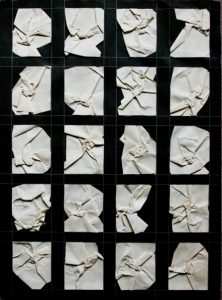 I don’t think they had a name at the time.
I don’t think they had a name at the time.
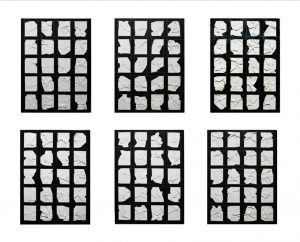
A grid of grids
I really did like the results. They existed on that edge between chaos and order where all the interesting things lie, but with a beautiful simplicity. I made half a dozen of them, the idea being that they be exhibited collectively, either in a single row along a wall or, if it was a big enough wall, in a double row – a grid – a grid of grids. (Actually, if I’d had the opportunity I’d have filled a large gallery room with them).
Looking back it is obvious that these flattened white forms on on their black backgrounds solved a problem in much the same way that the wooden sculptures had solved the problem that the wooden blocks had presented. The difference between the two starting points was that the crumpled paper forms were made; the wood had just been there – ‘ready made’ to use art world parlance. But the way in which the flattened forms were produced had a sufficiently random element to allow me to react in the same way.
The question was, having made half a dozen of them (and no large gallery space being on offer to justify making more) where to go next? I tried a few variations which worked quite well (see below) and a few different colours and shades of background paper, which didn’t. I decided to up the ante and dug out some charcoal. Freely applied on white paper, using the side of the stick, charcoal provided greater subtlety; its softness offered an additional contrast to the hard edge of the paper forms. It also gave me more avenues to explore.
It was freely applied but in the first series I used masks to create a kind of smoky grid and arranged larger but uncut crumpled pieces. 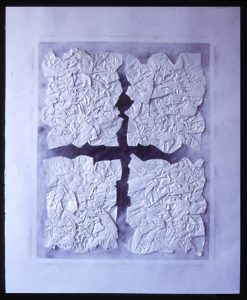 I actually made several of these with the same intentions as in ‘Flattened White Forms on a Black Background’. I then went on to try the odd variation, even producing, and framing, a couple of giant versions. I say ‘giant’, they weren’t big by art gallery standards but they certainly took up a good chunk of the living room wall in of our bijou semi-detached
I actually made several of these with the same intentions as in ‘Flattened White Forms on a Black Background’. I then went on to try the odd variation, even producing, and framing, a couple of giant versions. I say ‘giant’, they weren’t big by art gallery standards but they certainly took up a good chunk of the living room wall in of our bijou semi-detached
I obviously couldn’t carry on working on that scale – I was in danger of creating a bigger storage problem that ever. I returned to a more comfortable size and experimented. I didn’t just crumple and iron at this point, I tore, twisted, tied knots, tore some more, scribbled and glued. The result was a satisfying series of collages. I’m conscious now of two branches – a more tactile, slightly more three dimensional branch – exemplified by the Knot pieces ) and a flatter, more formalised series using grids. The two do meet briefly in the large ‘Cardboard Boxes and Brown Paper Grid’ piece.
They were satisfying to make and I find them satisfying to look at now. At the time they met with no response from anyone else outside my tiny circle. With John and his paintings leading the way (as ever) I hawked them round a few galleries in the North West and sent photographs of them further afield but without positive response.
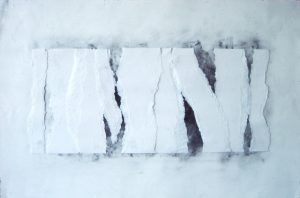
Torn Paper with Charcoal. Lived on various wall in various houses for several years.
Those that survived lived in folders behind various settees unseen by anyone but family and the odd friend. The exception is ‘Torn paper & Charcoal 1’ which, for some mysterious reason, has stayed in its frame and adorned the walls of the various dwellings I’ve inhabited since it was made. It’s now slightly darker than it was and the edges of the torn card have gone a bit brown.
Back To Contents.
Failure to get the paper collages exhibited didn’t distress me particularly. Even at the age of forty I still managed an optimism that flew in the face of an increasingly obvious reality. I remember reading an article by Waldemar Januszczak in which he insisted that there were no undiscovered artists of any worth in Britain. I simply dismissed this assertion as wrong. Well obviously it was wrong; there was John and me for a start. We might not be geniuses but our work definitely had some merit – worth definitely. We kept telling each other it had. And our relationship was certainly an important motivating factor in keeping us going. But more important was the activity itself, for me at least. Art problems were ones I could solve, unlike many of the more practical matters in life, like not having enough money, which I found much more difficult. And anyway (enter the above mentioned optimism, stage left) the next series of works would be the one that would make it; then all the problems would be over. (Of course I hadn’t given up on the first novel yet either, though doubts were beginning to creep in a little bit).
I started messing around with cardboard and, more significantly, paint – brightly coloured paint.
Colour was something that had hardly ever featured in my work up until then. This was partly because it simply hadn’t arisen as a factor but also because I was frightened of it. Once again, Art College is cast in the role of villain.
Early in my time at Manchester we were exposed to what is grandiosely described as colour theory. In the twenty minutes given over to the subject, we were introduced to the colour circle and through it exposed to such exciting notions as harmony, discords and complimentary colours. To my grammar school educated brain these ideas simply, as usual, took on the status of rules. And as rules they were merely inhibiting.
For a start, I didn’t really get harmony, as in which reds, say, harmonised with which. Presumably that was covered in the rules too (sub-section four, paragraph 7, perhaps, which our lecturer hadn’t got around to sharing with us). The discord made sense though its use was obviously fairly limited – to Op Art mainly. Which left complimentary colours. They did make a sort of sense. So there I was, with just the one rule to guide me – rule me in fact. From that moment on I couldn’t put a blue down on a painting without feeling obliged to stick orange next to it. And could I then add a red? Or would that break one of the harmony rules, whatever they actually were? And if I did add red, wouldn’t there have to be a green in there as well? No wonder I didn’t do much painting on that Intermediate course and sought the sanctuary of the pub instead.
And how astounding is it, that, under these circumstances I actually applied to join the Painting Department? And how utterly unsurprising that they said, ‘Don’t ring us – Next!’
The Sculpture Department on the other hand was much more user friendly. It was, when I joined it at least, virtually a colour free zone. Everything was either brown, grey, white or off black (as in clay, plaster and cement fondue). I was able to forget about my colour phobia and concentrate on getting confused about other things. Said phobia was able to settle down and bed in for the long haul, which it did, for a couple of decades or so at least. In fact there are remnants of it with me still if I’m not careful. But on the 1st April 1986 I managed to make a serious dent in it.
That’s a very precise date, I hear you cry, given that I haven’t been able to remember which year I was in at some points. Some sort of joke perhaps? Well, no, it just so happens that for a good chunk of 1986 (May to November) I actually wrote a diary. I think I was missing writing.
It is a revealing read in some ways and not always a comfortable one. Much of it is taken up describing attempts to cut down or stop drinki
ng, parts of it written when drunk and a lot of it quite boring. But it does mention the art work I was doing. There are no pictures in it unfortunately and my disinclination to give names to pieces means it isn’t the perfect aid memoire, but it certainly helps.
Towards the end of March I was still messing about with small bits of cardboard – as I had been for some time, creating small collage sketches which often ended up being mass produced and formed into grids. One of these got extended into a self-contained piece to which, for some reason, I added colour.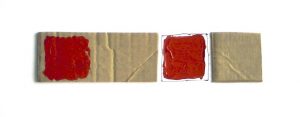
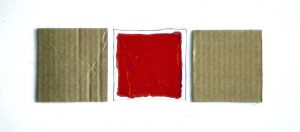
This led to a series of works in which the paint took on a more positive role. I’ll let the diary take over at this point. The works referred to are
Sunday 30th March 1.45 pm
‘I tried some simple collages yesterday using corrugated cardboard and oil paint. The results were messy but interesting – I intend to explore further today.’
4.32 pm
‘The paint and cardboard have led somewhere. It’s too early to assess but there is something. Roughly cut rectangles of cardboard and rectangular blobs of red paint – simple as ever but derived from complexity. The only problem is that the oil from the paint is spreading out from the colour. If it proves to be unacceptable I will have to get some acrylic – or work on treated board.’
11.25 pm
Typical! The oil has spread inexorably outwards (see 1st image below). Mind you, I’m not as sure I like them as much now. Still, they are going somewhere and I would like to explore further – except that I have no acrylic paint and it is Easter Monday tomorrow so no chance of getting any ‘till Tuesday (when I have no transport anyway). I can just see it now – I’ll just be getting somewhere and it will be back to school and the 16+ exhibitions!’
And so to the 1st April. John drove me into town to get some acrylic paint, then nipped in to see the little collages. ‘He liked them, of course,’ says the diary at 5.28 pm. It goes on:
‘I’ve since done some more – repeating the first with non-spreading acrylic. Inevitably it lacks something – a kind of freedom in the application of the paint. I shall have to keep them both- I assume I mean both the oil and acrylic versions. It goes on:
‘I have also tried the odd variation, the last being paint only – 3 squares – yellow, red and blue. It is fascinating – for years I have been frightened of colour but now I suddenly see it differently. It has merely become another component rather than a mysterious force with its own difficult to understand laws. Have I finally escaped from the tyranny of discords, harmonies, complimentaries and all the other rationalisations that my Art College lecturers so confused me with?’
From where I am now this was an incredibly important moment. Colour, about which I’d had something approaching a phobia, was suddenly reduced to the same level of problem as that presented by a pile of driftwood. Using it would still involve struggle with all the agonies and the ecstasies involved in making art but I was no longer frightened of it. I was never going to be a Matisse but I could still tackle it head on. And that is what I now proceeded to do.
Back To Contents.
It should have come as no great surprise to discover that using colour was simply about making choices. If I’d discovered one thing almost twenty years earlier in that post art college recovery period it was that the secret of making art is embodied in that image rich phrase ‘suck it and see’. I just hadn’t got around to applying that understanding to colour. But then, as I’ve already said, the problem of colour hadn’t really come up. Now it had.
And it had come up full frontally. It wasn’t just a question of deciding what colour scarf the girl in the foreground should be wearing or whether to change the colour of that jug in the still life. In the work which followed I was confronting colour as the subject of the work. I let my old friend the grid take care of the structure.
I worked at school to begin with, where the paint was rubbish but, like the cardboard I was putting it on, plentiful and cheap (in the sense that they were both free). This was an important consideration, judging by the constant references to the financial considerations in the diary. ‘…it would cost a fortune to do what I’ve been doing using acrylic,’ says an entry on the 16th May.
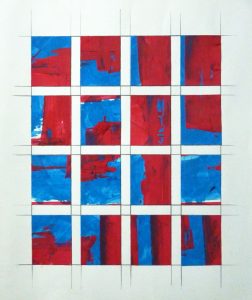
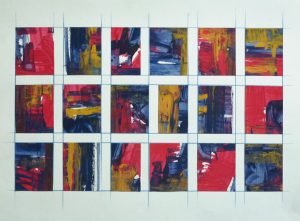 I had actually started the series a week earlier on the 9th doing several according to the diary. Only one survives. Interestingly, considering earlier remarks, the two colours make a discord. I doubt if it was meant since one of the constants of the process was squeezing the colour straight out of the tube, or in this case the plastic bottle.
I had actually started the series a week earlier on the 9th doing several according to the diary. Only one survives. Interestingly, considering earlier remarks, the two colours make a discord. I doubt if it was meant since one of the constants of the process was squeezing the colour straight out of the tube, or in this case the plastic bottle.
The following day I used three colours but managed to make a mistake in the cutting so that the pieces, though still rectangular weren’t quite identical. I actually saw this as major plus at the time. ‘I decided to incorporate the odd shapes and it seems to give it that something which the others lacked,’ says the diary. I don’t think it did become a major plus, or a major distraction either. The variation was minimal anyway and allowed the focus to remain on the colour.
I soon took the plunge and started to use more expensive acrylic paints. The results were much brighter, more colourful even. A representative collection can be seen below, These arrangements weren’t random, incidentally, but composed quite purposefully. Chance was a factor in the process but only in the same way that it can be in a freely painted ‘normal’ painting – the happy accident so beloved of watercolorists for example. It was applied a great deal more freely than that, and was further randomised by being cut up.
I still like these coloured grids and they were certainly liked by non-artist friends at the time – though given how those good people had presumably struggled with some of the earlier stuff these brightly coloured grids probably came as a breath of fresh air. They certainly did me good in that they demystified colour and helped conquer my nervousness of it.
More practically, the diary reminds me that I was still framing the paper collages during this period and sending off slides of these and the paint collages to various galleries. It comes as no surprise now that they excited little interest. They were on the one hand far from ground breaking and on the other too formally clinical to excite more parochial interest. At the time the lack of positive responses took its toll but then so were other aspects of my life. In fact the diary becomes a hard read as it reaches its final pages in late November. I think it’s fair to say that I was not a happy bunny.
‘I can remember years ago’ says the troubled cottontail,’ thinking of the artist as someone who suffers deep depression in return for [periods of] high elation. I felt it was a fair exchange in those days. But underlying that were two small children and a loving wife. I have none of that now….’
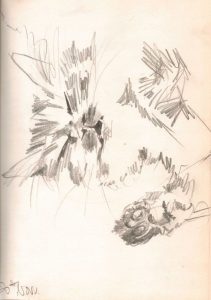 ‘Oh, for goodness sake, pull yourself together!’ I hear you cry, ‘Nobody actually died. Well, I did pull myself together. The diary says so. Four hours later, having done a cathartic sketch of the cat, been out with John and got on the outside of four large scotches I was feeling a lot more chipper.
‘Oh, for goodness sake, pull yourself together!’ I hear you cry, ‘Nobody actually died. Well, I did pull myself together. The diary says so. Four hours later, having done a cathartic sketch of the cat, been out with John and got on the outside of four large scotches I was feeling a lot more chipper.
But the fundamental malaise was still there. I began a second novel. By the time it was completed I was living in different accommodation with a different partner.
Two further unpublished novels followed. I carried on sketching occasionally but in the main I was a writer rather than an artist. I didn’t produce any artwork of any note for the next ten years and more.
Or did I?
Writing may have been my personal preoccupation during the years that followed but artwork still featured. It just wasn’t me who was producing it; it was my pupils, particularly the ones who had opted for the subject during their final two years.
I’ve written about this mini revolution in my Art teaching elsewhere (http://stumasonart.co.uk/writing/appendices/) so there’s no need to say too much here. Just that making Art through the medium of secondary school students satisfied a personal artistic need, and the results, both the images created and the exam results they gained were rewarding in their own right.
Getting the balance right between teacher and student input was never easy, though I never physically helped with the drawings and painting. But I have occasionally wondered if my contribution was too great, like the time I met a thirty-something ex pupil at Cartmel Races a few years after I’d finished teaching. She had been a relatively skilful student though not an academic one. I ended the conversation by asking if she still did any art work. “No,” she replied “I couldn’t somehow do it without you there.” It felt like failure and maybe it was, but I must remind myself that, according to one of my lecturers, most of the people I was at art college with had stopped making Art once they’d left college.
And I have received plenty positive feedback over the years. I occasionally still do, sometimes from friends who have met ex pupils in far flung places. One of my favourites, though was not a verbal compliment but an incident which happened whilst I was still teaching. It involved two girls who didn’t get any grades at all and is described in the link.
In the meantime, here are just a few of the images from the time. There are, of course, more on the page referred to.
Of course it all ended badly, as so much does. By the time I’d got on the wrong side of fifty-five the day to day grind of teaching was becoming something of a struggle. I was trying to finish mounting that year’s GCSE work when the elastic bands holding my critically fragile psyche together finally snapped. I didn’t, disappointingly, tear off all my clothes and attack the well-meaning but weak headteacher with a tin of red gloss paint, or better still, slay his loathsome deputy with a meat cleaver. What actually happened is that I suddenly stopped being able to function. My wife, a fellow teacher at the school, took me home and I never went back.
I was lucky having Judith still in the school because she was able to report back on the state I was in. That’s the problem with not taking the tin of gloss paint route, nobody really appreciates what a mess you’re in if you just walk. And of course you’re in no condition to explain, you’re too busy trying to work out what day it is.
When I had finally worked out that it was Tuesday (or was it Wednesday?) I was confronted with all the other consequences of my collapse, like the tendency to burst into tears at random moments and get into arguments with teenagers in parks (though not, thankfully at the same time). And then there was the depression, a depression the like of which I had never known before – and I have known a few. That descended on me like a suffocating blanket.
But time, says the sage, is a great healer, as of course is the NHS, the support of a good woman and a good friend to play snooker and drink whiskey with on a Thursday night (at least I think it was Thursday). So I did, eventually, get to a place where I could fight back. I resorted to writing at first, beginning a novel whose first chapter saw two eleven year old delinquents create havoc in a town centre before being shoved off a railway bridge into the path of an oncoming train. The unidentified perpetrator of this horrendous crime was to be revealed later in the narrative and may well have been a deranged teacher. It was fairly therapeutic until I started exploring the kids’ back stories by having a young journalist visit their family homes. I ended up writing sympathetically about the little monsters, which is not what I needed at all.
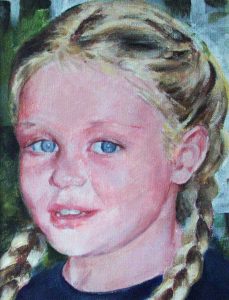
Laurie
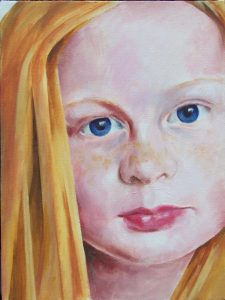
Becca aged 8
And then, one day, I started a painting. It was a portrait of my niece, Laurie. I had done drawings of her two brothers in the past, as presents, but had always failed to get a decent photograph of her. Sometime around the change of millennia I’d managed to get a useable image and, since I now had the time, I began a painting from it. It turned into a mighty struggle. I hadn’t painted for years and had really forgotten the discipline of it. But I sort of got there in the end. The feedback I got from this little painting was a definite fillip. It was like being nine again – I do a drawing (or in this case a painting), people say nice things about it, and I feel good. It had spurred me on when I was nine and it spurred me on this time too.
I did a painting of my then eight year old daughter Becca and from that got a commission.
One or two more commissions followed, and in the meantime I started getting a little more ambitious. It was, after all, the positive feedback that my damaged psyche needed and I was getting that from the act of painting, the solving of painterly problems and the responses I got to the results. I embarked on a larger canvas, of my eldest daughter and granddaughter Lucy. It wasn’t as successful as I’d have liked but it acted as a bridge to what followed later. And it didn’t cause any psychological damage – it wasn’t that bad.
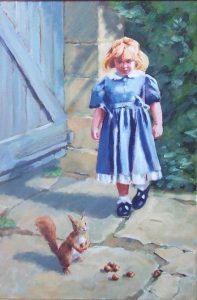
Becca Encountering a Squirrel
I was now painting for pleasure, or at least sanity. I found myself with the attitude that I’d had in my early writing days – I was just doing it for fun. So I was free to do and include anything, like the kind of sentimentality that I would have run a half marathon from in earlier years. Hence ‘ Becca Encountering a Squirrel’, the dubious result of an attempt at a narrative painting and an image put together from various elements. It was more difficult than I’d expected and made me appreciate the artistry of those Victorian painters whom I had previously dismissed as unworthy of my attention. I could even enjoy the results of that artistry, albeit with a smile and a sense of wonder at their lack of shame. It was wonderfully freeing, going to galleries and just enjoying what’s in there without prejudice. And it still is. Visiting art galleries and museums is now my favourite, non-creating, leisure activity.
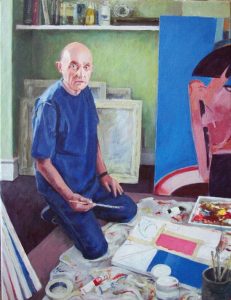
John Painting
Back at the easel, and in between those occasional commissions, I began a painting of John Still under the influence, to some extent, of the salon style I depicted him painting in what he then used as a studio – a small bedroom. Here was another struggle. It underwent several changes but I managed to resolve it more or less satisfactorily.
And then history started to intrude; my history, the one you’ve nearly finished reading about. I did a painting of my sonRupert. It was about half life-size, full length, without a background and very photographic in its style and feel. The cut out figures and the fascination with photographic imagery of a previous persona had nipped through a mental wormhole and intruded on my current consciousness. Or do I mean sub consciousness? I can’t remember, probably both.
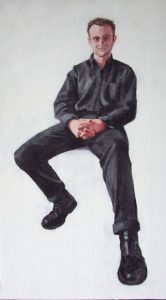
Rupert
It was inevitable that the next painting was going to be full size. It was of my eldest daughter, Jane again, who is inclined to dress differently from the common herd. I took loads of photographs of her in her self-made finery. All were taken at eye level, so much so that she had to stand on a stool for me to photograph her feet. I roughly stitched the bits together on the computer. I was fairly happy with the result but didn’t like any of the images of the face I’d taken on the first occasion so I took a load more a week later in a different location and in different, and better, lighting conditions. The result was ‘Jane’. I followed it with another of my younger daughter, the then 10year old Becca. I offered both for exhibition at The West Lancs Open in Ormskirk. Not only were they were accepted but I received enquiries about them: one from the curator of a gallery in one of the Liverpool universities and another from a chap called Martin Dauber who was putting together a book about fashion illustration and wanted to include ‘ Jane ’.
Jane’s image did end up in the’ Big Book of Fashion Illustration’ (page 136) but the curator didn’t get back to me. He probably didn’t like my CV. A 60 year old, undiscovered artist of quality doesn’t compute, unless you’re Alfred Wallis or Grandma Moses.
The incident did encourage me to enter ‘Jane’ for the Royal Society of Portrait Painters’ annual exhibition. It was accepted there too and exhibited at the Mall Galleries, next but one to a portrait of Princess Anne. The family had a good day out in London, going to see it, and when we got back my sister-in-law (who hadn’t been on the trip) commissioned me to paint her two sons Richard and Harry, brothers of Laurie whose painting had started it all. The result still adorns their expansive hallway.
Whilst all this was going on, John began to put one of his long term plans into action. He had for years talked about moving to Spain and when he retired (at about the same time that I did) he made a tentative move in that direction by buying a holiday apartment on the Costa Blanca. When his wife Carol retired a more permanent move became possible. He put his house up for sale, a deposit down on a villa and started cleaning his garage out. (Interestingly he discovered a small Fiat car under all the other rubbish, a vehicle he’d bought many years earlier as a runabout and never run about in. It demonstrates, if nothing else, how much bigger his garage was compared to mine, not to mention how much rubbish he’s thrown into it over the years).
I’ve got to admit that, much as I understood and sympathised with John’s motivations for making a move, I still felt a bit panicky at the prospect. Who was I going to talk to about Art? I didn’t know anybody else, not people who knew about Art, not like John and I knew about Art. I knew a few people who knew what they liked, many of them even liked my paintings, but they tended not to be people I could hold a leisurely conversation with – about Art that is. Attempts to do so always seemed to end up with me having to defend Carl Andre’s bricks and Tracy Emin’s bed.
I insisted John accompany me to a meeting of Preston Art Society before he left. Here he discovered a chap who had once bought one of his paintings (which I thought made him unique at the time but John assures me that he wasn’t). John talking to his one-time patron left me the opportunity to cast my eye over the rest of the membership. I didn’t really like what I saw. They had the look of a group of Sunday painters, though I couldn’t be sure because I didn’t talk to any of them. We stayed and watched the speaker, who gave an admittedly fascinating lecture about how to make watercolour paper; then left and went to the pub. I didn’t go back, at least not for a while.
In the months leading up to John’s departure, his daughter Nancy commissioned me to paint her two daughters, John’s then only grandchildren, as a going away present. The result (for which I didn’t charge obviously) is ‘John’s Granddaughters’. John gave me his last painting done on British soil (of a Spanish beach scene) on the day before he left.
Now alone in my personal, artist free zone, I got stuck into painting and produced another life sized figure in Matt.
And then, some months later, I went to a friend’s birthday party and met a lady called Dorothy, the host’s aunt, another retired teacher who was also a member of Preston Art Society. I had already decided by this time that I needed to throw out my prejudices and have another go; I just hadn’t the bottle to go on my own. Dorothy agreed to take me to the next meeting.
Thanks to Dorothy and a chap called Mike who came and chatted, I did manage to talk to a few people this time.
Of course it wasn’t as I had thought. Yes there are a few Sunday painters, but there is also a central core of ex Art teachers from the local sixth form college and others who exhibit both widely and successfully. What’s more it turns out that all these societies are really just the tail of a much larger beast. There is a whole network of painters, printmakers and other kinds of picture producers out there, much bigger, more active and more interconnected than I’d realised. I had, I suppose, been aware of them in my artistic peripheral vision but had dismissed them as being of little interest. And it is true that that none of them are setting up installations that explore the nature of reality or painting giant canvasses that challenge our understanding. The work of this particular beast is all a lot more comfortable than that, both in its size and subject matter. But that doesn’t mean there’s no artistry or challenge in the making. There is of course a good deal of both.
I suppose it could be argued that much of what goes on in this giant underbelly of the art world is more craft than art, and I suppose some of it might be. But personally, these days, I’m happy to be part of it, to continue to paint pictures and draw drawings and try very hard not to bother what category they fall into.
I got the whole thing into its true perspective on the train back from Ormskirk following the private view of the West Lancs Open. My painting ‘Snapshot’, had just received a commendation (and was to go on to win the Peoples Prize in the same exhibition and be one of the three prize winners at the Harris Open later in the year). Becca and I had just settled into our seats when a young chap got on the train and went to sit further down the carriage. I recognised him as one of that night’s top prize winners. He’d received his prize little more than an hour earlier. I found myself taking vicarious pleasure from his triumph, imagined a voice in his head saying “I’m an artist, an artist of worth”.
And despite the fact that I never won anything like a prize until after I got my bus pass (school 5th form Art Prize excepted) he reminded me of my earlier self. I used to be an artist just like that, I found myself thinking, with all that enthusiasm and hope. The thought didn’t cause me any unhappiness because I was content to be where I was, and what I was: just somebody who simply enjoys the act of painting, an activity that’s challenging yet uncomplicated – at least it is the way I do it.
Yes, I thought, I quite like that: ‘I used to be an artist but now I’m just an old guy who paints.’ I liked the ring of it, though undoubtedly there will be those who think it’s an admission of something sad, like failure. And I suppose it does have an element of self-protection in it. It says: Don’t ask me to explain or defend what I do; I’m just an old guy who paints, from photographs more often than not. I don’t care whether it’s art, or where it fits into the great scheme of things.
So it was with a certain irony that the first time I used it was when I did, for a little while, and then only temporarily, become a proper artist again.
“Do you not fancy going on one of those painting holiday things?” Mrs Mason has been known to ask during my occasional miserable moments. It is a good question because the idea of going off somewhere nice and warm for a few days and painting with a group of like-minded individuals has often wandered around in my head. It usually encounters signs saying things like “Avoid Landscape Painting – it’ll only end in tears,” and “Beware of Old Ladies with a touchy-feely approach to picture making.” Now I should stress that I’ve nothing against old ladies – some of my best friends are old ladies these days – and I don’t mind landscapes (though I never seem to be able to manage a full one), but I do suspect that the sort of courses that some of my arty socs chums go on wouldn’t suit me. Of course they might, but since I’d be shelling out a lot of pennies for the privilege of finding out I’ve never been inclined to take the chance.
And then, somewhere in the middle of 2010, one of the society members mentioned a course that she had been on the year before called Land Art. Now Gill, the lady in question, is an abstract printmaker whose work I like and whose opinion I respect so I had a second look. I liked what I saw. Land Art for me meant Richard Long mostly. I’ve been a fan of his since he started recording his antics on maps in the sixties; back in my traffic sign days in Chapter Two I was much enamoured of maps (and still am). Add in the sculptural nature of most Land Art and the course seemed to be worth the second look. The third look involved my credit card and the die was cast.
‘The historic estate and manor house of Briynduu’, to quote the brochure (http://www.creativeartsretreat.co.uk/index.htm), is a rambling old house with enough room to house half a dozen would be Land Artists in isolated comfort, and extensive grounds including a wood for Land Artists to play in and a studio big enough for the play to continue indoors. A short drive away is the coast with several coves and beaches for even more creative antics. My fellow students were Andrew, a very ambitious abstract/landscape painter, Olivia, a retired Librarian, a retired woodworker called Rupert, and Sue, a poet. Now I should stress that these labels are somewhat misleading in that Olivia had been a lot more than just a librarian (I never got the real details out of her), Rupert was obviously a lot more than a mere joiner and much travelled. Sue was also well travelled and a very successful poet with several books to her name and regular slots on Welsh Radio and Radio Four. Andrew was a South African and had his own gallery. Also in shot are tutors Helen, wife of the manor’s owner, and Marghed. Everybody was unreservedly nice (including me, the chap who used to be an artist but is now just an old guy who paints).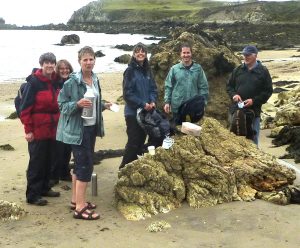
The notional length of the course was five days but since we arrived relatively late on the first, and the last was taken up with packing up to go home, the really productive days for most of us numbered three. Of the students, Olivia and Rupert seemed relatively new to the conceptual/practical nature of Land Art; Olivia admitted to struggling as the course progressed but with the help of Helen and Marghed produced some admirable stuff by the end. As did Rupert. Andrew, by contrast, was a powerhouse of productivity who was still working full on when I left on day 5. (Two of his pieces made the current brochure – the skirted trees on the About Us page and the stream-following snake of red stones on the Residential Courses page.) Poet Sue was a true creative soul who transferred her obviously excellent facility with words to wood, stone and seaweed with ease (though she did start putting the odd word on the odd stone by day four).
But now it’s time to talk about me. It is my history remember.
The course proper began on day two with an introduction to the subject, with pictures, followed by a short drive to the coast and a walk down to a pebbled cove. I’d intentionally left my cynicism at home and happily joined in with the looking far and near and occasional halts to draw the sounds. When we got to the cove we were given the concept of line and invited to get stuck in.
I started by sticking a bottle on a rock and drawing ripple lines round it in white chalk (the bottle was later blown off by the wind and I replaced it with a stone). I felt I’d copped out slightly with this bit of whimsy so I tried some proper Land Art by stuffing stones and seaweed into a crack in the rocks. I found the result unsatisfying. What’s more, when I looked at the photographs later I discovered that it resembled a giant bottom – doing what bottoms do. I went back to the chalk and attempted to create a straight line which went all the way down the beach – but only when viewed from the front. I ran out of time and chalk at about the same time. It was a project that needed a full day and at least one assistant, maybe armed with a brush or two and some water based paint.
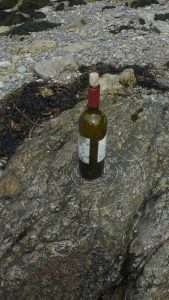
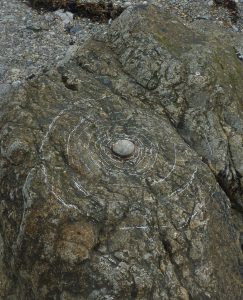
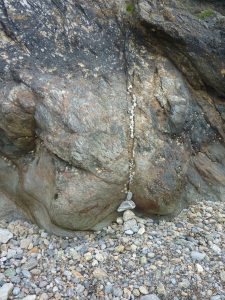
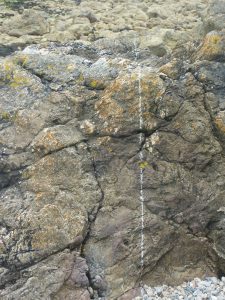
After a packed lunch we walked round the headland to another cove, the name of which, I was later to learn, was White Lady Bay. The subject now, said Marghed, was ‘colour’. White Lady Bay was the right place for it: the stones in it ranged from bright reds, oranges and ochres to purples and blues. There were black and white ones too. Chuck in a couple of shades of seaweed and you’d pretty well got the lot. I started collecting.
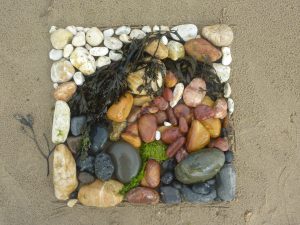
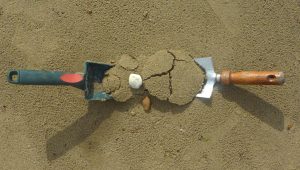 I claimed afterward, in the end of course feedback, that I’d had a blackout at this point – a jocular attempt to deny responsibility for what I went on to produce. I ended up with some kind of landscape. It was less a piece of Land Art, more a piece of embroidery in stone and seaweed. Olivia said she thought it pretty. I’m fairly sure I heard a sharp intake of breath from Marghed at the use of the P word – whatever Land Art is it’s never pretty (except, occasionally, in the hands of a certain Andy Goldsworthy perhaps) and I’d gone and produced something that was. I tried to rescue a little of my self-respect by making a small construct out of two trowels. It didn’t get chance to show it to anybody because someone nicked one of the trowels to dig with. Andrew, meanwhile, was putting the finishing touches to his brochure destined red stone snake and Sue a fabulous procession of little coloured cairns which disappeared off into a cave.
I claimed afterward, in the end of course feedback, that I’d had a blackout at this point – a jocular attempt to deny responsibility for what I went on to produce. I ended up with some kind of landscape. It was less a piece of Land Art, more a piece of embroidery in stone and seaweed. Olivia said she thought it pretty. I’m fairly sure I heard a sharp intake of breath from Marghed at the use of the P word – whatever Land Art is it’s never pretty (except, occasionally, in the hands of a certain Andy Goldsworthy perhaps) and I’d gone and produced something that was. I tried to rescue a little of my self-respect by making a small construct out of two trowels. It didn’t get chance to show it to anybody because someone nicked one of the trowels to dig with. Andrew, meanwhile, was putting the finishing touches to his brochure destined red stone snake and Sue a fabulous procession of little coloured cairns which disappeared off into a cave.
The old guy who returned to base was feeling a little deflated though I cheered up when someone opened a bottle of Cabernet Sauvignon at dinner. We students ate together in our section of the manor, and very good company we were too.
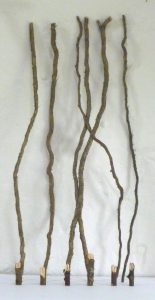
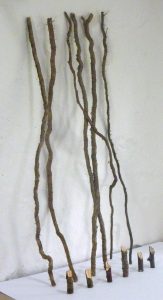 It was off into the woods on day three.
It was off into the woods on day three.
I had a good day in the woods. I didn’t produce anything actually in the woods but brought some of the woods into the studio and made a small installation. I was happy with the result.
On day four we were given a choice: coast or wood, do your own thing. I couldn’t wait to get back to that cove and all its coloured stones; I had a score to settle.
Sue came with me on the ten minute drive to the coastal car park. Twenty minutes into the journey I suggested we were lost. “We’re not lost. We’re just where we happen to be,” said Sue poetically. Twenty minutes after that I got out a map, and the satnav she’d earlier derided, and took us to the car park that we had happened to be heading for to begin with. We went down to White Lady Bay where Sue went off to make poetry with purple stones. She carried on with the theme of way markers that she had begun two days earlier with the little coloured cairns. This time she used arrows. Little surprise then, that I liked the result.
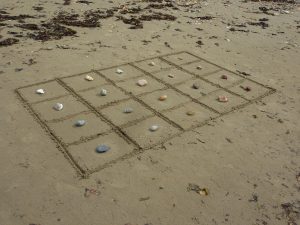 I meanwhile had started on my own agenda. I’d been chewing over the problem of what to do on this beach, on and off, for the last couple of days. It had been no gentle, absent minded mastication – I’d lost sleep over it. But by the time I put my rucksack down on a convenient rock I had a clear idea of how I was going impose myself on and integrate myself with that particular stretch of pebble littered sand.
I meanwhile had started on my own agenda. I’d been chewing over the problem of what to do on this beach, on and off, for the last couple of days. It had been no gentle, absent minded mastication – I’d lost sleep over it. But by the time I put my rucksack down on a convenient rock I had a clear idea of how I was going impose myself on and integrate myself with that particular stretch of pebble littered sand.
First was the problem of colour. Colour, my old, and apparently ongoing, bête-noir.
I had become increasingly aware of the importance, in Land Art in particular, of choice and context. In choosing this twig or that stone and placing it juxtaposition with other twigs, stones, trees or rocks, we altered its significance and its meaning. I wanted to pare this concept down to its essence. I began to experiment with a just two stones, first on the beach and later back at the manor. I gave one stone a function – that of paperweight – and, using it and my old friend the arrow, gave the other stone a specific, but undefined significance. The results, I felt, were promising if incomplete. 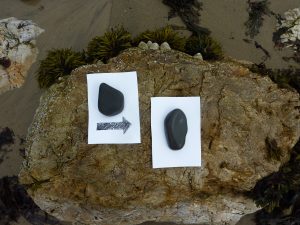
They remained incomplete, for the moment, because I ran out of time and the course came to an end. All that remained were the feedback sessions and, not long after that the goodbyes. “Stuart,” said Olivia, just before we went our separate ways. “You are not just an old guy who paints.” And she was right, for a while. What’s more the while lasted for a few more months.
Back in Penwortham the two stones became one which I began to carry around and photograph against various backgrounds and, eventually, with people. By placing it in juxtaposition with them I gave them a temporary significance, made permanent by photograph, and at the same time increased the significance and specialness of the stone itself. I ended up with lots of photographs, and the stone ended up in lots of people’s heads. But what to do with the photographs? I could make a book of them, as Marghed had taught us how to do in Anglesey. I actually tried one of these but it didn’t really work. The obvious solution of attempting to get the photographs exhibited in a gallery wasn’t really a viable option so in the end I settled, at Becca’s suggestion, on a Facebook page. This can still be seen, by Facebook members at least, by clicking (or copying and pasting) http://www.facebook.com/pages/A-Stone/134006706649025?sk=photos . You’ll notice that the page title uses the indefinite article because it really is just a stone although people do, understandably, refer to it as ‘the’, ‘ that’, or ‘your’ stone – as in “What happened to the stone?”. The answer to that occasional but increasingly rarely asked question is not much these days, although a couple of young American boys got a tiny bit excited about it a few weeks ago (well, they clicked the like button anyway). I’ve contemplate taking it back to White Lady Bay and returning it to anonymity. Conversely I’ve toyed with a display case or its own attractive, velvet lined box. We’ll see.
At the moment I’ve too much else to do. As I write, I’ve got a cat’s portrait to paint and some drawings to finish and frame for an upcoming art society exhibition. And there are a whole load of other graphic and painterly projects waiting to be tackled. And none of those will, I’m fairly sure, cause sleepless nights or leave me wondering: ‘What was that all about then?’
It’s a good question. What was it all about? And I’m not just talking about the stone.
That was where I’d got to at the end of 2012. I’ve changed website hostss since then and this little exercise of self indulgence has lain dormant since the change. I’ve reached the age where keeping up with the technology feels like trying to keeping up with Mo Farah in a marathon – it keeps disappearing over the horizon. It’s actually taken a worldwide pandemic and three months in lockdown for me to tackle it and if you’ve got this far you’ve no doubt encountered the odd glitch on the way.
Having said that I do actually find the technology quite exciting once I’ve managed to dip my feet into it past the ankles. I’m actually looking forward to exploring and expanding further now that I’ve got this far. (Steady Stu, remember your age).
Actually, some technology I’ve already embraced quite fully. The iPad Pro and it’s Apple Pencil have been a lot of fun to use (see digital drawings portfolio). And I really like the fact that there is no ‘original’ of these images in the traditional sense; that they only exist as noughts and ones in the ether, from where they can be reproduced in infinite numbers in print or pixel. Some of my more traditionally inclined arty friends are completely mystified by why anyone would do such a thing. For me it’s a slap in the face to the notion that Art should be precious just because it’s art. But that’s a discussion for another time and place.
In the meantime there is other artwork that I’ve produced over the last few years that doesn’t appear on the site because it isn’t always easy to categorise. Watch this space.
